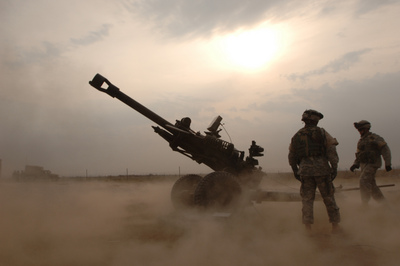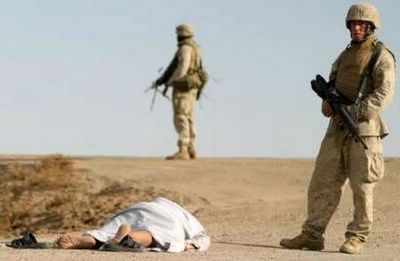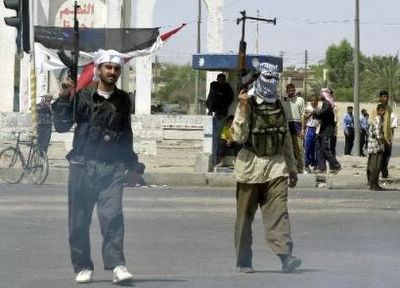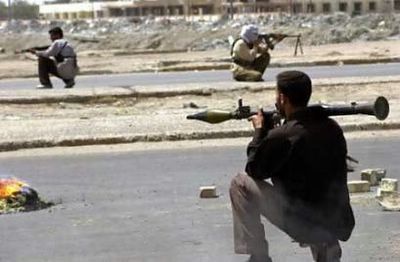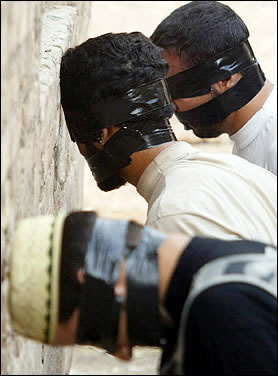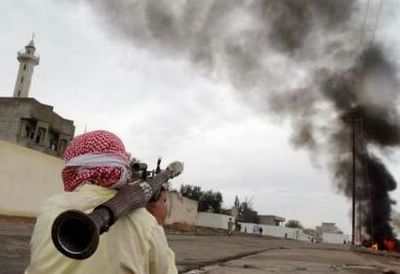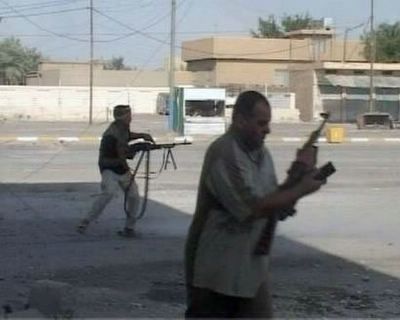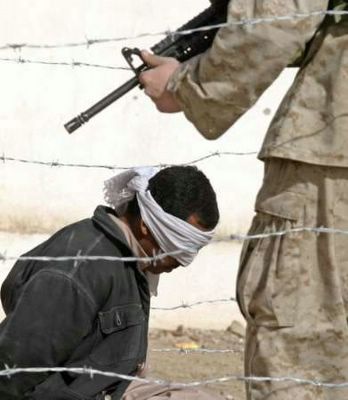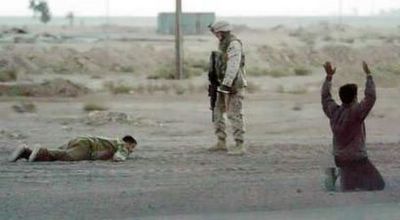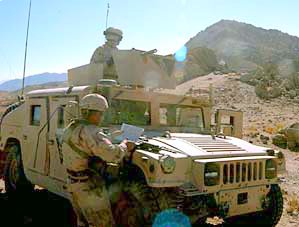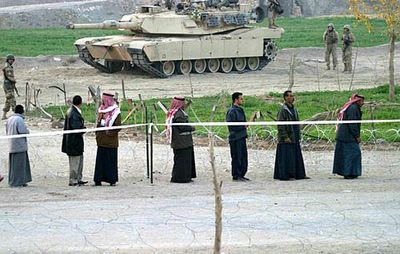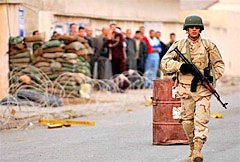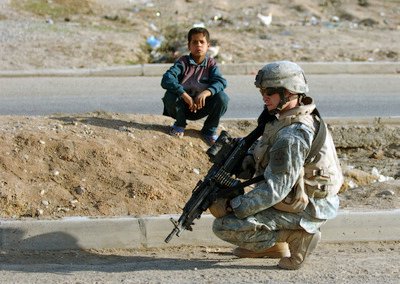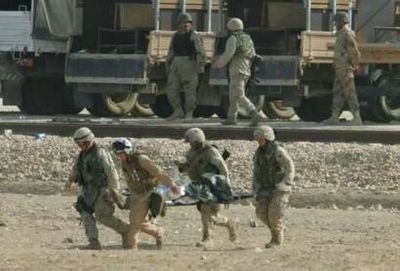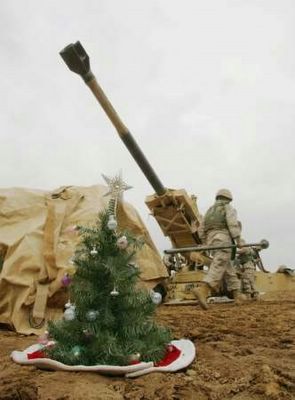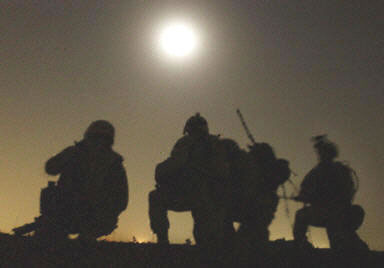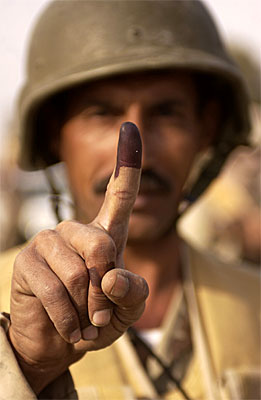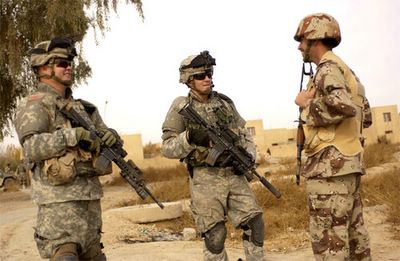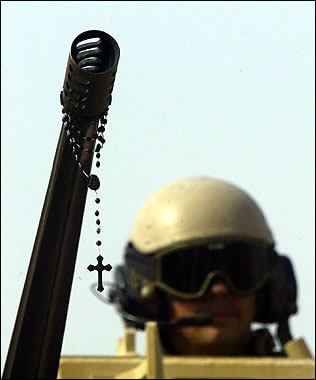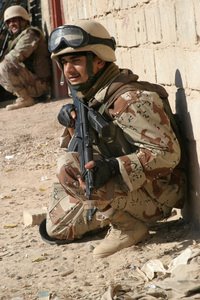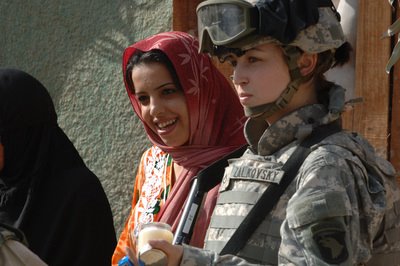Tuesday, December 27, 2005
Soldier Killed in Attack; Marines Kill Would-be Bomber
American Forces Press Service
WASHINGTON, Dec. 26, 2005 – A Task Force Baghdad soldier was killed today when a rocket-propelled grenade hit his vehicle while on patrol in Baghdad, military officials reported.
The soldier's name is being withheld until next of kin are notified.
Also today, U.S. Marines killed a would-be suicide bomber at an entry control point in central Fallujah.
The terrorist, armed with an explosive vest filled with ball bearings, detonated the bomb as he approached the checkpoint, but the vest only partially exploded, officials said. As the bomber tried to detonate the rest of the explosives, he was killed by Marine gunfire.
No Iraqi or U.S. military personnel were injured, but one civilian was reported wounded in the attack.
(Compiled from Multinational Force Iraq news releases.)
WASHINGTON, Dec. 26, 2005 – A Task Force Baghdad soldier was killed today when a rocket-propelled grenade hit his vehicle while on patrol in Baghdad, military officials reported.
The soldier's name is being withheld until next of kin are notified.
Also today, U.S. Marines killed a would-be suicide bomber at an entry control point in central Fallujah.
The terrorist, armed with an explosive vest filled with ball bearings, detonated the bomb as he approached the checkpoint, but the vest only partially exploded, officials said. As the bomber tried to detonate the rest of the explosives, he was killed by Marine gunfire.
No Iraqi or U.S. military personnel were injured, but one civilian was reported wounded in the attack.
(Compiled from Multinational Force Iraq news releases.)
Police, Firefighters, U.S. Soldiers Respond to Baghdad Attacks
American Forces Press Service
WASHINGTON, Dec. 26, 2005 – Iraqi police, firefighters and Task Force Baghdad soldiers responded to a series of car bomb attacks in central and eastern Baghdad today, military officials reported.
At 8:30 a.m., a suicide car bomber detonated in the Karadah district, killing an Iraqi civilian and wounding an Iraqi police officer and an Iraqi civilian. The second car bomb exploded in eastern Baghdad at about 10 a.m., injuring five Iraqi police officers. At 10:43 a.m., a third car bomb detonated near an Iraqi police patrol in northeast Baghdad, killing four Iraqi civilians and wounding two Iraqi police officers. About two minutes later in central Baghdad, a fourth suicide car bomber wounded four Iraqi civilians and two Iraqi police officers.
Officials at Multinational Force Iraq's Combined Press Information Center in Baghdad said they had yet to receive any information on a possible fifth attack being reported by some news organizations.
In other news from Iraq, separate roadside bombs killed two Task Force Baghdad soldiers Dec. 25 in Baghdad. Their names are being withheld pending notification of their families.
On Dec. 24, a rocket-propelled grenade attack near Hawijah in northern Iraq killed Army Sgt. Myla L. Maravillosa, 24, of Wahiawa, Hawaii. Maravillosa was assigned to the Army Reserve's 203rd Military Intelligence Battalion, Aberdeen Proving Ground, Md.
Elsewhere in Iraq, troops from the 3nd Battalion, 1st Brigade, 1st Iraqi Intervention Force, discovered two caches north of Qaim on Dec. 25. The caches consisted of a rocket-propelled grenade launcher, a heavy machine gun, an AK-47 assault rifle and assorted loose ammunition. The caches were turned over to the authorities for disposal.
Soldiers from the 2nd Battalion, 2nd Brigade, 1st Iraqi Intervention Force discovered a cache and detained a suspected insurgent Dec. 25. A cache consisting of two grenades, a 60 mm mortar tube, 10 sticks of TNT, 5 pounds of C-4 explosive, a spool of detonation cord and a box of blasting caps were found during a cordon search in Fallujah. Later, the troops' detained a suspect at an entry control point northwest of Fallujah. The cache was turned over to authorities, and the suspect was detained pending further investigation.
Seven terrorists were killed in two failed attacks Dec. 24 in Iraq's Salah Ad Din province. Police in Samarra responded to an explosion and discovered the bodies of three unidentified men. The men were attempting to fire an 82-mm mortar at an unknown target when the round detonated prematurely. A fourth terrorist was taken to a local medical facility, officials said, but died from his injuries while attempting to escape.
A short time later, a patrol from the 3rd Infantry Division's 1st Brigade Combat Team foiled a would-be ambush near Duluiyah. Terrorists attacked the patrol with small-arms fire, but the soldiers quickly identified and engaged them, killing three. No soldiers were injured in the engagement, officials said.
An air assault mission conducted Dec. 23 by 1st Battalion, 187th Infantry Regiment, resulted in the capture of several suspected terrorists and the seizure of a large ammunition cache.
Elements from Company C, 1-187, landed in Muslakhah aboard UH-60 Black Hawk helicopters and began searching the village for individuals listed as being involved with terrorist activities in the area. Within an hour of touching down, they identified and detained two people on the list of suspects.
"Every day, we win small victories," said Capt. Christopher Judge, Company C commander. "But when we can get someone on our list, it is a huge boost." By the day's end, the unit had apprehended six terrorism suspects.
During the air assault mission, soldiers of Company D, 1-187, began an amphibious assault on an island in the Tigris River adjacent to Muslakhah. While patrolling the banks of the island, they discovered a cache of more than 100 mortar rounds - 45 82 mm rounds and 64 120 mm rounds. They also seized 20 rockets and 600 rounds of small-arms ammunition.
The town of Muslakhah, north of Fatah, is located near an oil pipeline under construction, which officials said will bring much-needed revenue to the area when complete. Attacks on the workers have disrupted its construction in the past, but have stopped since the 187th took over the area Nov. 1, officials noted, adding that regiment soldiers continue to work with Iraqi forces to reduce attacks and safeguard the pipeline.
Coalition aircraft flew 36 close air support missions Dec. 25 for Operation Iraqi Freedom. U.S. Air Force F-15s provided close-air support to coalition troops near Balad, destroying an enemy mortar location with a precision-guided bomb. U.S. Air Force F-16s, a Predator and Royal Air Force GR-4s provided close-air support to coalition troops near Baqubah. The GR-4s struck an enemy firing position. Other U.S. F-15s provided close-air support to coalition troops in near Baghdad. Nine U.S. Air Force and U.S. Navy intelligence, surveillance and reconnaissance aircraft flew missions in support of operations in Iraq.
(Compiled from Multinational Force Iraq, Multinational Security Transition Command Iraq and U.S. Central Command Air Forces Forward news releases.)
WASHINGTON, Dec. 26, 2005 – Iraqi police, firefighters and Task Force Baghdad soldiers responded to a series of car bomb attacks in central and eastern Baghdad today, military officials reported.
At 8:30 a.m., a suicide car bomber detonated in the Karadah district, killing an Iraqi civilian and wounding an Iraqi police officer and an Iraqi civilian. The second car bomb exploded in eastern Baghdad at about 10 a.m., injuring five Iraqi police officers. At 10:43 a.m., a third car bomb detonated near an Iraqi police patrol in northeast Baghdad, killing four Iraqi civilians and wounding two Iraqi police officers. About two minutes later in central Baghdad, a fourth suicide car bomber wounded four Iraqi civilians and two Iraqi police officers.
Officials at Multinational Force Iraq's Combined Press Information Center in Baghdad said they had yet to receive any information on a possible fifth attack being reported by some news organizations.
In other news from Iraq, separate roadside bombs killed two Task Force Baghdad soldiers Dec. 25 in Baghdad. Their names are being withheld pending notification of their families.
On Dec. 24, a rocket-propelled grenade attack near Hawijah in northern Iraq killed Army Sgt. Myla L. Maravillosa, 24, of Wahiawa, Hawaii. Maravillosa was assigned to the Army Reserve's 203rd Military Intelligence Battalion, Aberdeen Proving Ground, Md.
Elsewhere in Iraq, troops from the 3nd Battalion, 1st Brigade, 1st Iraqi Intervention Force, discovered two caches north of Qaim on Dec. 25. The caches consisted of a rocket-propelled grenade launcher, a heavy machine gun, an AK-47 assault rifle and assorted loose ammunition. The caches were turned over to the authorities for disposal.
Soldiers from the 2nd Battalion, 2nd Brigade, 1st Iraqi Intervention Force discovered a cache and detained a suspected insurgent Dec. 25. A cache consisting of two grenades, a 60 mm mortar tube, 10 sticks of TNT, 5 pounds of C-4 explosive, a spool of detonation cord and a box of blasting caps were found during a cordon search in Fallujah. Later, the troops' detained a suspect at an entry control point northwest of Fallujah. The cache was turned over to authorities, and the suspect was detained pending further investigation.
Seven terrorists were killed in two failed attacks Dec. 24 in Iraq's Salah Ad Din province. Police in Samarra responded to an explosion and discovered the bodies of three unidentified men. The men were attempting to fire an 82-mm mortar at an unknown target when the round detonated prematurely. A fourth terrorist was taken to a local medical facility, officials said, but died from his injuries while attempting to escape.
A short time later, a patrol from the 3rd Infantry Division's 1st Brigade Combat Team foiled a would-be ambush near Duluiyah. Terrorists attacked the patrol with small-arms fire, but the soldiers quickly identified and engaged them, killing three. No soldiers were injured in the engagement, officials said.
An air assault mission conducted Dec. 23 by 1st Battalion, 187th Infantry Regiment, resulted in the capture of several suspected terrorists and the seizure of a large ammunition cache.
Elements from Company C, 1-187, landed in Muslakhah aboard UH-60 Black Hawk helicopters and began searching the village for individuals listed as being involved with terrorist activities in the area. Within an hour of touching down, they identified and detained two people on the list of suspects.
"Every day, we win small victories," said Capt. Christopher Judge, Company C commander. "But when we can get someone on our list, it is a huge boost." By the day's end, the unit had apprehended six terrorism suspects.
During the air assault mission, soldiers of Company D, 1-187, began an amphibious assault on an island in the Tigris River adjacent to Muslakhah. While patrolling the banks of the island, they discovered a cache of more than 100 mortar rounds - 45 82 mm rounds and 64 120 mm rounds. They also seized 20 rockets and 600 rounds of small-arms ammunition.
The town of Muslakhah, north of Fatah, is located near an oil pipeline under construction, which officials said will bring much-needed revenue to the area when complete. Attacks on the workers have disrupted its construction in the past, but have stopped since the 187th took over the area Nov. 1, officials noted, adding that regiment soldiers continue to work with Iraqi forces to reduce attacks and safeguard the pipeline.
Coalition aircraft flew 36 close air support missions Dec. 25 for Operation Iraqi Freedom. U.S. Air Force F-15s provided close-air support to coalition troops near Balad, destroying an enemy mortar location with a precision-guided bomb. U.S. Air Force F-16s, a Predator and Royal Air Force GR-4s provided close-air support to coalition troops near Baqubah. The GR-4s struck an enemy firing position. Other U.S. F-15s provided close-air support to coalition troops in near Baghdad. Nine U.S. Air Force and U.S. Navy intelligence, surveillance and reconnaissance aircraft flew missions in support of operations in Iraq.
(Compiled from Multinational Force Iraq, Multinational Security Transition Command Iraq and U.S. Central Command Air Forces Forward news releases.)
Monday, December 26, 2005
THREE TERRORISTS CAUGHT EMPLACING BOMB
BAGHDAD, Iraq ©¤ Three terrorists were captured as they were caught emplacing a hoax roadside bomb in east Baghdad Dec. 21.
At about 6 p.m., a patrol from 3rd Squadron, 7th Cavalry observed a civilian vehicle dropping cement blocks in the median of a major thoroughfare. The patrol intercepted the suspicious vehicle and detained three suspected terrorists.
Additional elements of 3-7 CAV secured the site surrounding the suspicious items and an explosive ordnance disposal team investigated the objects and found them to be hoax roadside bombs.
¡°These suspected terrorists were not placing cement blocks in the road for any other reason than to terrorize and intimidate the population. They are currently being detained at a military detention facility,¡± said Maj. Paul Reese, operations officer for 2nd Brigade, 3rd Infantry Division.
¡°Anyone found guilty of emplacing a hoax roadside bomb is a terrorist ¨C make no mistake about it; the good people of Iraq are disgusted by these types of games.¡±
Hoax roadside bombs are commonly used by terrorists to check how Iraqi Security and Coalition Forces will react.
At about 6 p.m., a patrol from 3rd Squadron, 7th Cavalry observed a civilian vehicle dropping cement blocks in the median of a major thoroughfare. The patrol intercepted the suspicious vehicle and detained three suspected terrorists.
Additional elements of 3-7 CAV secured the site surrounding the suspicious items and an explosive ordnance disposal team investigated the objects and found them to be hoax roadside bombs.
¡°These suspected terrorists were not placing cement blocks in the road for any other reason than to terrorize and intimidate the population. They are currently being detained at a military detention facility,¡± said Maj. Paul Reese, operations officer for 2nd Brigade, 3rd Infantry Division.
¡°Anyone found guilty of emplacing a hoax roadside bomb is a terrorist ¨C make no mistake about it; the good people of Iraq are disgusted by these types of games.¡±
Hoax roadside bombs are commonly used by terrorists to check how Iraqi Security and Coalition Forces will react.
MOSUL MEDIA EMIR AND ADMINISTRATOR CAPTURED
FOR IMMEDIATE RELEASE
BAGHDAD, Iraq – An Ansar al-Sunna of Mosul Media Emir and Administrator were captured by Coalition Forces during raids on suspected terrorist safe houses near Mosul.
Muhammad ‘Amir Husayn Mar’I al-Sufi, known as Abu Naba, was an Ansar al-Sunna media emir in Mosul and ‘Adnan ‘Abd-al-Wahab ‘Abdallah Mahmud al-Badrani, known as Abu Hudayfah, an Ansar al-Sunna administrator, were captured Nov. 23 and Dec. 5, 2005 respectively.
Abu Naba was responsible for disseminating propaganda - in this capacity, he produced propaganda fliers and compact disks focusing on military operations, anti-voting messages, Jihad messages and prayers.
He also facilitated videos of attacks on Iraqi and Coalition Forces to be posted to the Internet. He purchased cameras for terrorists to film violent acts including bombings, kidnappings and executions. Abu Naba helped produce the final video products and delivered the videos to other Ansar al-Sunna leaders for posting on the Internet.
Based on information Abu Naba and other detained terrorists provided to Coalition Forces, Abu Hudayfah, allegedly in charge of logistics and support for Ansar al-Sunna of Mosul was also identified and captured.
FOR MORE INFORMATION, PLEASE CONTACT THE COMBINED PRESS INFORMATION CENTER at: cpicpressdesk@iraq.centcom.mil.
BAGHDAD, Iraq – An Ansar al-Sunna of Mosul Media Emir and Administrator were captured by Coalition Forces during raids on suspected terrorist safe houses near Mosul.
Muhammad ‘Amir Husayn Mar’I al-Sufi, known as Abu Naba, was an Ansar al-Sunna media emir in Mosul and ‘Adnan ‘Abd-al-Wahab ‘Abdallah Mahmud al-Badrani, known as Abu Hudayfah, an Ansar al-Sunna administrator, were captured Nov. 23 and Dec. 5, 2005 respectively.
Abu Naba was responsible for disseminating propaganda - in this capacity, he produced propaganda fliers and compact disks focusing on military operations, anti-voting messages, Jihad messages and prayers.
He also facilitated videos of attacks on Iraqi and Coalition Forces to be posted to the Internet. He purchased cameras for terrorists to film violent acts including bombings, kidnappings and executions. Abu Naba helped produce the final video products and delivered the videos to other Ansar al-Sunna leaders for posting on the Internet.
Based on information Abu Naba and other detained terrorists provided to Coalition Forces, Abu Hudayfah, allegedly in charge of logistics and support for Ansar al-Sunna of Mosul was also identified and captured.
FOR MORE INFORMATION, PLEASE CONTACT THE COMBINED PRESS INFORMATION CENTER at: cpicpressdesk@iraq.centcom.mil.
IRAQ: LARGE CACHE DESTROYED NEAR BAYJI
FOR IMMEDIATE RELEASE
TIKRIT, Iraq – Soldiers from the 101st Airborne Division’s 3rd Brigade Combat Team thought they had discovered a single cache of weapons near Bayji Dec. 20 after a tip from a local resident. On Dec. 23, the Soldiers finished unearthing the last of the weapons from the eleventh cache at the site.
“This place is basically an ammo supply point for the enemy,” said Capt. Matt Bartlett, commander of Company B, 1st Battalion, 187th Infantry Regiment. “Any attack they wanted to do, whether an IED or small-arms, they could get what they needed here.”
The Rakkasan Soldiers slammed the door to the supply point Dec. 23 with three immense detonations conducted by an explosive ordnance disposal team.
More than 1,600 rockets and missiles, 283 large artillery shells, 27 anti-tank mines and 80 assault weapons were pulled from the ground along with nearly a ton of bulk explosives.
It was unclear if the cache was in use by terrorists prior to its excavation. Fresh tire tracks and the lack of wear on some of the weapons and packaging indicated that the deposits were new. In other caches, the weapons were corroded and had documentation with entries ending in 1984, dating them back to before the first Gulf War.
Whether the cache was active or not, its contents will never be used to harm anyone thanks to the three labor-intensive days the Soldiers spent excavating the site. In most cases the sites were dug up with shovels then loaded and consolidated by hand.
The resident who tipped off the Soldiers about the cache not only ensured the safety of the local residents from AIF attacks, but also collected a reward of $2,500 for the tip. The U.S. and its allies offer rewards for any information that lead to the capture of certain high profile terrorists and the tools utilized in their trade. This cache find will certainly hamper the enemy’s ability to carry out future attacks against the civilians, security forces of Iraq and all of the Coalition Forces trying to ensure the democratic process will find a peaceful home here in Iraq.
TIKRIT, Iraq – Soldiers from the 101st Airborne Division’s 3rd Brigade Combat Team thought they had discovered a single cache of weapons near Bayji Dec. 20 after a tip from a local resident. On Dec. 23, the Soldiers finished unearthing the last of the weapons from the eleventh cache at the site.
“This place is basically an ammo supply point for the enemy,” said Capt. Matt Bartlett, commander of Company B, 1st Battalion, 187th Infantry Regiment. “Any attack they wanted to do, whether an IED or small-arms, they could get what they needed here.”
The Rakkasan Soldiers slammed the door to the supply point Dec. 23 with three immense detonations conducted by an explosive ordnance disposal team.
More than 1,600 rockets and missiles, 283 large artillery shells, 27 anti-tank mines and 80 assault weapons were pulled from the ground along with nearly a ton of bulk explosives.
It was unclear if the cache was in use by terrorists prior to its excavation. Fresh tire tracks and the lack of wear on some of the weapons and packaging indicated that the deposits were new. In other caches, the weapons were corroded and had documentation with entries ending in 1984, dating them back to before the first Gulf War.
Whether the cache was active or not, its contents will never be used to harm anyone thanks to the three labor-intensive days the Soldiers spent excavating the site. In most cases the sites were dug up with shovels then loaded and consolidated by hand.
The resident who tipped off the Soldiers about the cache not only ensured the safety of the local residents from AIF attacks, but also collected a reward of $2,500 for the tip. The U.S. and its allies offer rewards for any information that lead to the capture of certain high profile terrorists and the tools utilized in their trade. This cache find will certainly hamper the enemy’s ability to carry out future attacks against the civilians, security forces of Iraq and all of the Coalition Forces trying to ensure the democratic process will find a peaceful home here in Iraq.
AIR ASSAULT OPERATION NETS SUSPECTS, WEAPONS CACHE
December 24, 2005
Release Number: 05-12-73
FOR IMMEDIATE RELEASE
TIKRIT, Iraq -- An air assault mission conducted by 1st Battalion, 187th Infantry Regiment, resulted in the capture of several suspected terrorists and the seizure of a large cache of ammunition in Muslakhah, Iraq, Dec. 23.
Elements from Company C, 1-187, landed in Muslakhah aboard UH-60 Blackhawk helicopters and began searching the village for individuals listed as being involved with terrorist activities in the area. Within one hour of touching down, they identified and detained two individuals on the list of suspects.
“Every day we win small victories,” said Capt. Christopher Judge, commander, Company C. “But when we can get someone on our list, it is a huge boost.”
By the day’s end, the unit had apprehended six individuals.
During the air assault mission, Soldiers of Company D, 1-187, began an amphibious assault on an island in the Tigris River adjacent to Muslakhah. While patrolling the banks of the island, they discovered a cache of more than 100 mortar rounds – 45-82mm rounds and 64-120mm rounds. They also seized 20 rockets and 600 rounds of small arms ammunition.
“We are trying to make it difficult for [terrorists] to operate [in Mulakhah],” Judge said.
The town of Muslakhah, north of Al Fatah, is located near an oil pipeline that is under construction, which will bring much needed revenue to the area when complete. Attacks on the workers have disrupted its construction in the past, but have stopped since the Rakkasans took over the area Nov. 1. The Rakkasans continue to work with Iraqi forces to reduce attacks and safeguard the pipeline.
Release Number: 05-12-73
FOR IMMEDIATE RELEASE
TIKRIT, Iraq -- An air assault mission conducted by 1st Battalion, 187th Infantry Regiment, resulted in the capture of several suspected terrorists and the seizure of a large cache of ammunition in Muslakhah, Iraq, Dec. 23.
Elements from Company C, 1-187, landed in Muslakhah aboard UH-60 Blackhawk helicopters and began searching the village for individuals listed as being involved with terrorist activities in the area. Within one hour of touching down, they identified and detained two individuals on the list of suspects.
“Every day we win small victories,” said Capt. Christopher Judge, commander, Company C. “But when we can get someone on our list, it is a huge boost.”
By the day’s end, the unit had apprehended six individuals.
During the air assault mission, Soldiers of Company D, 1-187, began an amphibious assault on an island in the Tigris River adjacent to Muslakhah. While patrolling the banks of the island, they discovered a cache of more than 100 mortar rounds – 45-82mm rounds and 64-120mm rounds. They also seized 20 rockets and 600 rounds of small arms ammunition.
“We are trying to make it difficult for [terrorists] to operate [in Mulakhah],” Judge said.
The town of Muslakhah, north of Al Fatah, is located near an oil pipeline that is under construction, which will bring much needed revenue to the area when complete. Attacks on the workers have disrupted its construction in the past, but have stopped since the Rakkasans took over the area Nov. 1. The Rakkasans continue to work with Iraqi forces to reduce attacks and safeguard the pipeline.
Iraqi Soldiers Discover Weapons Caches, Detain Terror Suspects
American Forces Press Service
WASHINGTON, Dec. 23, 2005 – Iraqi army troops discovered several weapons caches and took suspected terrorists into custody Dec. 22 as they continue to take on more responsibility for their nation's security, military officials reported today.
Troops from the 3rd Battalion, 1st Brigade, 1st Iraqi Intervention Force, discovered a cache of 12 anti-tank mines, two 82 mm mortar rounds and one 120 mm mortar round, and another containing two 130 mm artillery rounds, an 82 mm mortar round, three rocket-propelled grenade boosters, two anti-tank mines and two 120 mm mortar rounds, officials said.
An explosives team destroyed both caches in place.
Elsewhere in Iraq, troops from the 3rd Battalion, 1st Brigade, 7th Iraqi Army Division, discovered a weapons cache while patrolling along the north shore of the Euphrates River north of Ramadi. The patrol discovered a mortar tube and base plate, as well as an outboard motor. A further search yielded a cache of seven 60 mm mortar rounds.
When an explosives team was called to destroy the cache, an improvised explosive device was discovered 200 meters from the cache, officials said. Both the cache and the IED were safely destroyed.
In Khalidiyah, troops from the 2nd Battalion, 3rd Brigade, 1st Iraqi Intervention Force, were manning a vehicle checkpoint when they stopped the men's vehicle and discovered two 82 mm mortar tubes in the back of the truck. The tubes were seized and the suspects were detained pending further investigation.
Troops from the 3rd Battalion, 1st Brigade, 4th Iraqi Army Division, also detained a man suspected of involvement in insurgent activities west of Balad.
(Compiled from Multinational Security Transition Command news releases.)
WASHINGTON, Dec. 23, 2005 – Iraqi army troops discovered several weapons caches and took suspected terrorists into custody Dec. 22 as they continue to take on more responsibility for their nation's security, military officials reported today.
Troops from the 3rd Battalion, 1st Brigade, 1st Iraqi Intervention Force, discovered a cache of 12 anti-tank mines, two 82 mm mortar rounds and one 120 mm mortar round, and another containing two 130 mm artillery rounds, an 82 mm mortar round, three rocket-propelled grenade boosters, two anti-tank mines and two 120 mm mortar rounds, officials said.
An explosives team destroyed both caches in place.
Elsewhere in Iraq, troops from the 3rd Battalion, 1st Brigade, 7th Iraqi Army Division, discovered a weapons cache while patrolling along the north shore of the Euphrates River north of Ramadi. The patrol discovered a mortar tube and base plate, as well as an outboard motor. A further search yielded a cache of seven 60 mm mortar rounds.
When an explosives team was called to destroy the cache, an improvised explosive device was discovered 200 meters from the cache, officials said. Both the cache and the IED were safely destroyed.
In Khalidiyah, troops from the 2nd Battalion, 3rd Brigade, 1st Iraqi Intervention Force, were manning a vehicle checkpoint when they stopped the men's vehicle and discovered two 82 mm mortar tubes in the back of the truck. The tubes were seized and the suspects were detained pending further investigation.
Troops from the 3rd Battalion, 1st Brigade, 4th Iraqi Army Division, also detained a man suspected of involvement in insurgent activities west of Balad.
(Compiled from Multinational Security Transition Command news releases.)
Monday, December 19, 2005
Small-Arms Fire Claims Marine's Life; Iraqi Soldiers Disrupting Enemy
American Forces Press Service
WASHINGTON, Dec. 19, 2005 – A U.S. Marine was killed by small-arms fire in Ramadi, Iraq, Dec. 18, military officials announced today.
The name of the deceased, assigned to the 2nd Marine Division, 2nd Marine Expeditionary Force (Forward), is being withheld pending notification of next of kin.
In other news, soldiers from three Iraqi battalions kicked off a cordon-and-knock operation, called Operation Moonlight, east of Ubaydi today. The operation is aimed at disrupting insurgent activities along the Euphrates River, officials said. Operation Moonlight participants include soldiers from 1st Brigade, 1st Iraqi Army Division, backed up by U.S. troops from 3rd Battalion, 6th Marines, Regimental Combat Team 2, and 2nd Marine Aircraft Wing (Forward).
"This is the first large-scale operation planned and executed by Iraqi soldiers of the 1st Brigade," a U.S. military spokesman noted. "The operation objective of Moonlight is to disrupt insurgent activity along the northern and southern banks of the Euphrates River near Ubaydi."
Officials pointed out that the eastern Qaim region, including the cities of Husaybah, Karabilah and Ubaydi, was cleared of al Qaeda in Iraq-led insurgents during Operation Steel Curtain in November. "The operations enabled residents to vote in the Dec. 15 Iraqi national elections," the spokesman said.
In operations over Iraq, coalition aircraft flew 50 close-air-support missions Dec. 18, including supporting coalition troops, infrastructure protection, reconstruction activities and operations to deter and disrupt terrorist activities, Air Force officials announced today.
Air Force F-16 jets blasted a cave used by anti-Iraqi forces with precision-guided munitions near Tal Afar, officials said. In other action, 12 U.S. Air Force, U.S. Navy and Royal Australian Air Force intelligence, surveillance and reconnaissance aircraft flew missions in support of operations in Iraq. Also, U.S. Air Force and British Royal Air Force fighter aircraft performed in a non-traditional ISR role with their electro-optical and infrared sensors.
(Compiled from Multinational Force Iraq and U.S. Central Command Air Forces Forward news releases.)
Related Sites:
WASHINGTON, Dec. 19, 2005 – A U.S. Marine was killed by small-arms fire in Ramadi, Iraq, Dec. 18, military officials announced today.
The name of the deceased, assigned to the 2nd Marine Division, 2nd Marine Expeditionary Force (Forward), is being withheld pending notification of next of kin.
In other news, soldiers from three Iraqi battalions kicked off a cordon-and-knock operation, called Operation Moonlight, east of Ubaydi today. The operation is aimed at disrupting insurgent activities along the Euphrates River, officials said. Operation Moonlight participants include soldiers from 1st Brigade, 1st Iraqi Army Division, backed up by U.S. troops from 3rd Battalion, 6th Marines, Regimental Combat Team 2, and 2nd Marine Aircraft Wing (Forward).
"This is the first large-scale operation planned and executed by Iraqi soldiers of the 1st Brigade," a U.S. military spokesman noted. "The operation objective of Moonlight is to disrupt insurgent activity along the northern and southern banks of the Euphrates River near Ubaydi."
Officials pointed out that the eastern Qaim region, including the cities of Husaybah, Karabilah and Ubaydi, was cleared of al Qaeda in Iraq-led insurgents during Operation Steel Curtain in November. "The operations enabled residents to vote in the Dec. 15 Iraqi national elections," the spokesman said.
In operations over Iraq, coalition aircraft flew 50 close-air-support missions Dec. 18, including supporting coalition troops, infrastructure protection, reconstruction activities and operations to deter and disrupt terrorist activities, Air Force officials announced today.
Air Force F-16 jets blasted a cave used by anti-Iraqi forces with precision-guided munitions near Tal Afar, officials said. In other action, 12 U.S. Air Force, U.S. Navy and Royal Australian Air Force intelligence, surveillance and reconnaissance aircraft flew missions in support of operations in Iraq. Also, U.S. Air Force and British Royal Air Force fighter aircraft performed in a non-traditional ISR role with their electro-optical and infrared sensors.
(Compiled from Multinational Force Iraq and U.S. Central Command Air Forces Forward news releases.)
Related Sites:
Iraqi Citizens Support Ongoing Anti-Terror Ops
American Forces Press Service
WASHINGTON, Dec. 18, 2005 – As Iraq progresses militarily and democratically, citizens there are stepping forward to inform indigenous and coalition forces of terrorist operations and covert weapons caches, Multinational Force Iraq officials reported today. Iraqi citizens sometimes even are apprehending suspected terrorists themselves, officials noted.
For example, on Dec. 17, a group of Iraqi citizens near Kirkuk, in northern Iraq, captured two suspected terrorists who were observed digging up a weapons cache. The citizens reportedly subdued the suspects and called the Kirkuk Joint Coordination Center, which then relayed the information to a nearby patrol. The combined Iraqi and U.S. patrol responded and secured more than 20 artillery rounds, while detaining the terrorist suspects for questioning, officials said.
Also on Dec. 17, another group of Kirkuk residents flagged down a U.S. Air Force patrol and led the airmen to a small weapons cache. The airmen reportedly found two mortar rounds, two rocket-propelled grenade warheads and several anti-aircraft artillery rounds. An explosive ordnance disposal team destroyed the weapons in a controlled detonation, officials said.
A tip from a local citizen in the Tissa Nissan area of Baghdad Dec. 16 led a group of soldiers from the 1st Battalion, 64th Armor Brigade, to a large, buried mortar cache of seven 60 mm mortar rounds. The soldiers reviewed the site and reportedly discovered another suspicious site, which had 19 60 mm mortar rounds. An explosive ordnance disposal team destroyed the ammunition, officials said.
Iraqi soldiers, too, are stepping forward to take the lead, officials said. Iraqi army troops from the 3rd Battalion, 1st Brigade, 1st Iraqi Intervention Force, reportedly found and cleared two weapons caches near Husaybah Dec. 17.
The first cache, northwest of the city, held six 40 mm rounds, three AK-47s, a single assault rifle and assorted small arms ammunition, officials said. The second cache of 50 82 mm fuses was found in a water tank, northeast of town. The ordnance was collected and slated for subsequent destruction, officials said.
Elsewhere in Iraq, on Dec. 15, soldiers with the Task Force Band of Brothers discovered a large cache of improvised explosive device components near Hawijah. The components reportedly were found by a pair of scout helicopters from the 101st Airborne Division.
The helicopter pilots spotted suspicious activity by several individuals, officials said. They then relayed the suspects' location to a nearby patrol from the division's 1st Brigade Combat Team. The patrol found a weapons cache buried in several 55-gallon drums.
The cache consisted of 414 two-way radios, 48 circuit boards, and more than 100 timing devices -- all of which are used to manufacture IEDs. The cache also included small amounts of AK-47 ammunition, detonation cord, batteries and several bomb-making manuals, officials said.
This was the second time in less than a month that 1st Brigade Combat Team has uncovered a major cache in its area. The team discovered more than 4,200 mortar rounds in a single cache Nov. 27 near Kirkuk, officials said.
Meanwhile, at several locations near Tikrit on Dec. 17, soldiers from the 101st Combat Aviation Brigade detained 15 suspected terrorists as part of Operation Eagle Watch.
The 101st soldiers reportedly were conducting an area reconnaissance near Forward Operating Base Speicher, when they observed the terrorist suspects at two separate sites. Unit UH-60 Blackhawk helicopters swooped down to investigate. They found several AK-47 rifles, two sniper rifles, an RPK Soviet machine gun, and hundreds of rounds of ammunition, officials said.
The contraband was confiscated from the suspects, who then were taken to a nearby detention facility for questioning.
Officials reported one American fatality in Iraq Dec. 16. A Marine assigned to the 2nd Marine Logistics Group, II Marine Expeditionary Force (Forward), died from a non-hostile gunshot wound in Camp Fallujah.
The name of the deceased is being withheld pending notification of next of kin and release by the Department of Defense. The incident is currently under investigation, officials said.
(Compiled from various Multinational Force Iraq news releases.)
WASHINGTON, Dec. 18, 2005 – As Iraq progresses militarily and democratically, citizens there are stepping forward to inform indigenous and coalition forces of terrorist operations and covert weapons caches, Multinational Force Iraq officials reported today. Iraqi citizens sometimes even are apprehending suspected terrorists themselves, officials noted.
For example, on Dec. 17, a group of Iraqi citizens near Kirkuk, in northern Iraq, captured two suspected terrorists who were observed digging up a weapons cache. The citizens reportedly subdued the suspects and called the Kirkuk Joint Coordination Center, which then relayed the information to a nearby patrol. The combined Iraqi and U.S. patrol responded and secured more than 20 artillery rounds, while detaining the terrorist suspects for questioning, officials said.
Also on Dec. 17, another group of Kirkuk residents flagged down a U.S. Air Force patrol and led the airmen to a small weapons cache. The airmen reportedly found two mortar rounds, two rocket-propelled grenade warheads and several anti-aircraft artillery rounds. An explosive ordnance disposal team destroyed the weapons in a controlled detonation, officials said.
A tip from a local citizen in the Tissa Nissan area of Baghdad Dec. 16 led a group of soldiers from the 1st Battalion, 64th Armor Brigade, to a large, buried mortar cache of seven 60 mm mortar rounds. The soldiers reviewed the site and reportedly discovered another suspicious site, which had 19 60 mm mortar rounds. An explosive ordnance disposal team destroyed the ammunition, officials said.
Iraqi soldiers, too, are stepping forward to take the lead, officials said. Iraqi army troops from the 3rd Battalion, 1st Brigade, 1st Iraqi Intervention Force, reportedly found and cleared two weapons caches near Husaybah Dec. 17.
The first cache, northwest of the city, held six 40 mm rounds, three AK-47s, a single assault rifle and assorted small arms ammunition, officials said. The second cache of 50 82 mm fuses was found in a water tank, northeast of town. The ordnance was collected and slated for subsequent destruction, officials said.
Elsewhere in Iraq, on Dec. 15, soldiers with the Task Force Band of Brothers discovered a large cache of improvised explosive device components near Hawijah. The components reportedly were found by a pair of scout helicopters from the 101st Airborne Division.
The helicopter pilots spotted suspicious activity by several individuals, officials said. They then relayed the suspects' location to a nearby patrol from the division's 1st Brigade Combat Team. The patrol found a weapons cache buried in several 55-gallon drums.
The cache consisted of 414 two-way radios, 48 circuit boards, and more than 100 timing devices -- all of which are used to manufacture IEDs. The cache also included small amounts of AK-47 ammunition, detonation cord, batteries and several bomb-making manuals, officials said.
This was the second time in less than a month that 1st Brigade Combat Team has uncovered a major cache in its area. The team discovered more than 4,200 mortar rounds in a single cache Nov. 27 near Kirkuk, officials said.
Meanwhile, at several locations near Tikrit on Dec. 17, soldiers from the 101st Combat Aviation Brigade detained 15 suspected terrorists as part of Operation Eagle Watch.
The 101st soldiers reportedly were conducting an area reconnaissance near Forward Operating Base Speicher, when they observed the terrorist suspects at two separate sites. Unit UH-60 Blackhawk helicopters swooped down to investigate. They found several AK-47 rifles, two sniper rifles, an RPK Soviet machine gun, and hundreds of rounds of ammunition, officials said.
The contraband was confiscated from the suspects, who then were taken to a nearby detention facility for questioning.
Officials reported one American fatality in Iraq Dec. 16. A Marine assigned to the 2nd Marine Logistics Group, II Marine Expeditionary Force (Forward), died from a non-hostile gunshot wound in Camp Fallujah.
The name of the deceased is being withheld pending notification of next of kin and release by the Department of Defense. The incident is currently under investigation, officials said.
(Compiled from various Multinational Force Iraq news releases.)
Sunday, December 18, 2005
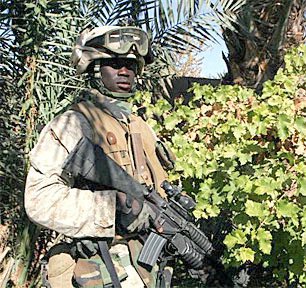
By Cpl. Ruben D. Maestre
2nd Marine Division
CAMP KOREAN VILLAGE, Iraq, Dec. 16, 2005 � Many people traveling to America arrive seeking personal gain and economic opportunity. Three weeks after Lance Cpl. Pascal R. Cisse arrived in the states from Germany, he elbowed his way into Marine Corps recruit training and eventually into the famed Marine Corps infantry.
�The recruiter told me I could go to boot camp in two months,� said the native of Dakar, Senegal. �I told him I wanted to join as soon as possible.�
The Marine recruiter he contacted in Tukwila, Wash., highlighted some of the job opportunities offered by the Marines, but Cisse (pronounced �Seece�) was adamant about becoming an infantryman.
�The recruiter wanted to give me a desk job,� said the 27-year-old. �I wanted to be infantry and I wanted (its specialized) training.�
Cisse�s response characterized his desire to take on challenges ever since childhood. In a young age category for the martial art of judo, the future Marine infantryman became a national champion in his native country. He left Africa for France at age 19 after completing high school and tried out for the French Foreign Legion. There, Cisse had a change of heart, opted out and began college studies in Germany.
Yet he said the yearning for the �military life� never left him. Soon, he was hearing about the legendary U.S. Marine Corps on the news, on documentaries and reading books about the elite fighting force. Eventually, every time he logged on the Internet, Cisse found himself going to Marine Corps� websites to find more information.
�It was a challenge for me to test myself,� said Cisse, assigned to 3rd Platoon, Company E, 2nd Battalion, 1st Marine Regiment. �I had heard that the Marines were tough and I wanted that challenge.�
The tall Marine from Africa, who reads his French-language Bible and understands English, speaks two indigenous languages from his native country, attended college classes in Germany and graduated Marine boot camp as an honor graduate in his training cycle. Positive traits he has applied in the past continue to be put into use in Iraq.
�He is a damned good Marine, he�s really loyal,� said Sgt. Caleb F. Pleasants, 23, of Whitefish, Mont., and squad leader in 3rd Platoon. �I don�t have to double-check his job because he gets it done.�
Cisse put his linguistic skills to use during Operation Steel Curtain, using some basic Arabic he learned from a language course in his command. He is eager to take on such challenges and Cisse feels so certain about joining the Corps, he is aiming for citizenship and considering staying in for a career.
�Being able to train, being able to travel, meeting people from all around � when we are asked to go, we always go and get the job done,� said Cisse of his mission as a warrior.
As he echoes the Marine motto Semper Fidelis � Always Faithful � it can be understood that Cisse has found a home, at least for now, in the U.S. Marines.
�I�m fighting for the man to my left and to my right so that we can all get home,� he said. �We are always faithful.�
Saturday, December 17, 2005

Unit Uses Special Skills to Pursue Enemy
Long range surveillance (LRS) detachments are melded into the Army�s new vision for the future.
By Spc. Jon Arguello 173d Infantry Brigade Public Affairs
KANDAHAR AIRFIELD, Afghanistan, Dec. 16, 2005 � Over five days in December a specialized unit from the 173rd Infantry Brigade (Airborne) defined flexibility. The special detachment proved themselves as a valuable asset as they eliminated a group of enemy fighters, including one high value target Dec. 5. The special skills and flexibility of a long range surveillance (LRS) detachment such as the 74th Long Range Surveillance Detachment make the unit especially adapted to meet the needs of an infantry brigade in this environment, said Maj. Michael Loos, the 173rd Airborne Brigade�s operations and planning officer.
"The LRS detachment is very adept at many missions we employ here in Afghanistan. Their tremendous day and night capabilities and training is perfect for this terrain." U.S. Army Maj. Michael Loos
�The LRS detachment is very adept at many missions we employ here in Afghanistan,� said Loos. �Their tremendous day and night capabilities and training is perfect for this terrain.� As the long-range surveillance detachments are melded into the Army�s new vision for the future, the 74th underwent its own transformation here in Afghanistan. Much of the adjustment came after the 74th�s change of command when Capt. Dirk Ringgenberg assumed command of the unit after his own string of extremely successful victories as the commander of Chosen Company 2nd Battalion 503rd Infantry (Airborne). �I wasn�t an expert on the conventional tactics of a LRS detachment,� said Ringgenberg. �So I just took the awesome skills of its leaders and soldiers and mixed them with what I knew about a standard infantry company.� Normally a LRS detachment is outfitted with six teams, one communications section and a headquarters section. The six teams, led by staff sergeants, work independently under the guidance of the commander to fulfill its reconnaissance missions. Now, the unit is separated into a Black team led by Ringgenberg and a Gold team led by the 74th�s executive officer, Capt. Casey Thoreen. Both teams also have Afghan National Army soldiers attached to their teams. �Usually a LRS detachment is comprised of six teams who all have their independent characteristics and talents,� said the detachment�s first sergeant, 1st Sgt. Randy Collins, from Walla Walla, Wash. �But after our change of command, the commander got together with the brigade staff and talked about how best to keep us employed. Now all our teams, who had six different ways to skin a cat, learned to do things in a more unified way.� But this diverse group of noncommissioned officers, most ranger qualified, most having held their own shuras and made their own village assessments, have used their vast range of experiences to make the transformation successful, while remaining as lethal as ever.
U.S. Army Staff Sgt. Jose Banuelos plans a route where no roads go on his way to his objective as Spc. Tony Sobiesczyk pulls security from the turret of a 74th Long Range Surveillance Detachment vehicle. U.S. Army photo By Spc. Jon Arguello
Flexibility has always been a part of the detachment�s character, explained the detachment�s senior staff sergeant. �You can�t always have a perfect plan,� said Staff Sgt. Jose Banuelos, from Oceanside, Calif. �The enemy can change things and you have to change with them to close in on them or accomplish the mission. It�s almost standard operating procedure that things won�t go exactly as planned. You just have to be ready to support each other.� That was the case during their early December mission as the 74th would split up, one group maintaining their blocking position and the other responding to the aid of a downed aircraft. Throughout the mission the plan changed again and again, leaving one group to dismount and race through a valley to the suspected target�s location while the other group pursued a separate group of enemy fighters. In the end, one element was poised to assault the enemy while the other group, several kilometers away, coordinated for close air support. Eventually U.S. Air Force A-10s were authorized and the joint tactical air controller with the far away group painted the picture for the pilots to destroy the targets. It�s obvious whatever changes in the detachment�s scheme, in combination with the vast experience of their unit�s staff sergeants, have only increased the flexibility and lethality of the 74th�s paratroopers. With the capability to take on any mission, mounted or dismounted, during the day or under the cover of darkness, the LRSD is being used more than ever to eliminate the enemy�s safe havens in Southern Afghanistan. �I�m proud of my guys,� said Collins. �They get a lot of tasks handed to them and they do a great job. They are constantly adjusting to the needs of the brigade and they stand ready to execute any mission that brigade sees fit or comes their way. They do an awesome job every day, including their performance during this particular mission.�
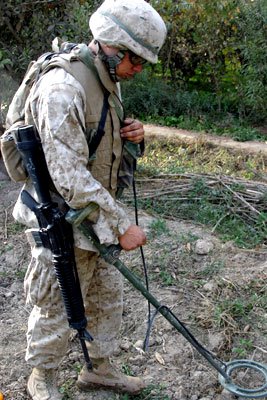
U.S. Marine Corps Lance Cpl. Justin Witcomb, an engineer attached to Weapons Company, 2nd Battalion, 6th Marine Regiment, uses a metal detector to search a local village for hidden weapons caches during an operation in Saqlawiyah, Iraq, Dec. 5, 2005. U.S. Marine Corps photo by Lance Cpl. Mark E. Morrow
Soldier breathes life into Iraqi child
December 15, 2005
Release A05215k
MOSUL, IRAQ - Security forces from Task Force Freedom conducted a miraculous act on a young Iraqi boy in Mosul December 15. Soldiers were patrolling a neighborhood near a home where an Iraqi man was seen holding a lifeless baby who had drowned in the flooded basement of their home. The child had a blue tone to his body as a medic, SPC Lucas Crowe, from 2nd Battalion, 1st Infantry Regiment administered aid to the 3-year old boy. The child became responsive, released water from his mouth and screamed a cry that Soldiers were elated to hear. After resuscitating the young boy, the combat medic from 2-1 Infantry turned the child on his side and monitored his breathing until an ambulance arrived.
Multi-National Forces of Task Force Freedom continue efforts to aid Iraqi citizens and assist them in providing security.
Release A05215k
MOSUL, IRAQ - Security forces from Task Force Freedom conducted a miraculous act on a young Iraqi boy in Mosul December 15. Soldiers were patrolling a neighborhood near a home where an Iraqi man was seen holding a lifeless baby who had drowned in the flooded basement of their home. The child had a blue tone to his body as a medic, SPC Lucas Crowe, from 2nd Battalion, 1st Infantry Regiment administered aid to the 3-year old boy. The child became responsive, released water from his mouth and screamed a cry that Soldiers were elated to hear. After resuscitating the young boy, the combat medic from 2-1 Infantry turned the child on his side and monitored his breathing until an ambulance arrived.
Multi-National Forces of Task Force Freedom continue efforts to aid Iraqi citizens and assist them in providing security.
Polling Center Incident Shows Iraqis' Spirit, Casey Says
By Gerry J. Gilmore
American Forces Press Service
WASHINGTON, Dec. 16, 2005 – The top U.S. military officer in Iraq said today he knew Iraqi officials and security forces had matters well in hand in the days prior to the Dec. 15 election.
"Everywhere that I went, I left with the feeling that we were dealing with confident and competent Iraqi leaders who had this election under control," Army Gen. George W. Casey Jr. said from his headquarters in Iraq during a satellite news conference with Pentagon reporters.
The Dec. 15 election boasted the highest participation - estimated at 65 to 70 percent of registered Iraqi voters - compared to the previous two Iraqi elections held Jan. 30 and Oct. 15, Casey said.
"And the levels of violence were below both January and October," Casey said. "The Iraqi security forces also performed superbly across Iraq as they maintained security on the polling sites."
The four-star general, commander of Multinational Force Iraq, related a story about terrorists who were trying to destroy a polling site at a school in Karmah, Iraq, on the night before the election. He said the terrorists knocked down a wall with a homemade bomb. Yet, the facility, located between Baghdad and Fallujah, was quickly repaired, Casey said.
"The Iraqis fixed it and were open for business and polling at 7 o'clock in the morning," Casey said. "That was the spirit that led the day," he said.
Casey cited the accomplishments made across Iraq in less than three years as "unprecedented."
"If you think about it, Saddam Hussein was still ruling Iraq three years ago and tyrannizing the Iraqi people," the general pointed out. Today, the Iraqis are liberated from Hussein's brutal regime, Casey said, and are rebuilding their nation according to democratic principles contained in their new constitution.
"Yesterday, they elected an assembly that will form a government to lead them for the next four years," Casey said, despite the efforts of a stubborn insurgency.
Casey said American servicemembers who've served in Iraq should also take credit for Iraq's latest successful election. "And particularly the loved ones of our fallen comrades," the general said.
The new Iraqi government will soon take the reins and begin work in confronting the country's challenges, Casey said. The general predicted Iraqi political debate whether or not to amend the country's new constitution and over federalism. But the terrorists won't be silent, Casey said, while Iraqi legislators debate and discuss their country's future. "I expect that these debates will be done against a background of violence," the general said. But he added that as the political process continues, the insurgency will lose much of its steam.
"We should not expect the insurgency to just go away because of yesterday's great success," Casey said, "but we should expect it to be gradually weakened and reduced as more and more Iraqis adopt the political process, and the root causes of the insurgency are addressed by the new Iraqi government and by the coalition."
American Forces Press Service
WASHINGTON, Dec. 16, 2005 – The top U.S. military officer in Iraq said today he knew Iraqi officials and security forces had matters well in hand in the days prior to the Dec. 15 election.
"Everywhere that I went, I left with the feeling that we were dealing with confident and competent Iraqi leaders who had this election under control," Army Gen. George W. Casey Jr. said from his headquarters in Iraq during a satellite news conference with Pentagon reporters.
The Dec. 15 election boasted the highest participation - estimated at 65 to 70 percent of registered Iraqi voters - compared to the previous two Iraqi elections held Jan. 30 and Oct. 15, Casey said.
"And the levels of violence were below both January and October," Casey said. "The Iraqi security forces also performed superbly across Iraq as they maintained security on the polling sites."
The four-star general, commander of Multinational Force Iraq, related a story about terrorists who were trying to destroy a polling site at a school in Karmah, Iraq, on the night before the election. He said the terrorists knocked down a wall with a homemade bomb. Yet, the facility, located between Baghdad and Fallujah, was quickly repaired, Casey said.
"The Iraqis fixed it and were open for business and polling at 7 o'clock in the morning," Casey said. "That was the spirit that led the day," he said.
Casey cited the accomplishments made across Iraq in less than three years as "unprecedented."
"If you think about it, Saddam Hussein was still ruling Iraq three years ago and tyrannizing the Iraqi people," the general pointed out. Today, the Iraqis are liberated from Hussein's brutal regime, Casey said, and are rebuilding their nation according to democratic principles contained in their new constitution.
"Yesterday, they elected an assembly that will form a government to lead them for the next four years," Casey said, despite the efforts of a stubborn insurgency.
Casey said American servicemembers who've served in Iraq should also take credit for Iraq's latest successful election. "And particularly the loved ones of our fallen comrades," the general said.
The new Iraqi government will soon take the reins and begin work in confronting the country's challenges, Casey said. The general predicted Iraqi political debate whether or not to amend the country's new constitution and over federalism. But the terrorists won't be silent, Casey said, while Iraqi legislators debate and discuss their country's future. "I expect that these debates will be done against a background of violence," the general said. But he added that as the political process continues, the insurgency will lose much of its steam.
"We should not expect the insurgency to just go away because of yesterday's great success," Casey said, "but we should expect it to be gradually weakened and reduced as more and more Iraqis adopt the political process, and the root causes of the insurgency are addressed by the new Iraqi government and by the coalition."
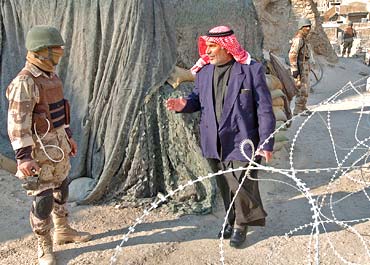
ELECTION SECURITY � Iraqi Army soldiers provide security for one of the polling sites at Tall Afar, Iraq, Dec. 15, 2005, for the Parliamentary Election of the first 4-year Iraqi government. Iraqi Army Security Forces with assistance from the 3rd Armored Cavalry Regiment and 82nd Airborne Infantry Regiment unit are providing security for the region of Tall Afar in order to disrupt insurgent safe havens and to clear weapons cache. U.S. Navy Photo by Petty Officer 1st Class Alan D. Monyelle
Friday, December 16, 2005
IRAQI AND COALITION FORCES HELP PAVE THE WAY FOR VOTERS IN AL ANBAR
December 15, 2005
Release Number: 05-12-41
FOR IMMEDIATE RELEASE
AR RAMADI, Iraq— Iraqi Security and Coalition Forces helped pave the way for hundreds of thousands of Iraqi citizens in Al Anbar Province to vote in today’s National Parliamentary Elections.
Voter turnout was robust throughout the province, with preliminary reports indicating that a far higher percentage of the predominantly Sunni population participated in today’s elections than did in October’s Constitutional Referendum. Overall, there were few security incidents reported in the Province, and the murder and intimidation campaign that kept many people from the polls during previous votes never materialized.
“Today’s vote exceeded all expectations,” said Assistant Division Commander, Brig. Gen. James L. Williams. “What we saw today was the result of months of hard work by the Iraqi government, the US Ambassador and his staff, the international community, particularly the IECI and Iraqi and Coalition Forces. Most of all, it clearly demonstrates the resolve of the local Iraqi people to take their rightful place in the democratic process.”
In the provincial capital of Ramadi, where only several thousand citizens took part in the Referendum, tens of thousands of voters lined the streets to vote today. Residents were observed dancing, singing and waving the Iraqi flag in a rare display of national pride. Members of both the Iraqi Army and the Iraqi Police provided security throughout the city while Coalition Forces remained largely on the outskirts in the event they were needed for an emergency. It is still too early to tell what percentage of voters in the city actually voted, but the numbers are expected to be much higher than they were during the Referendum.
In Fallujah, where an estimated 90% of voters participated in October’s Referendum, voter turnout in today’s elections was similarly high. As in Ramadi, Coalition Forces turned over much of the responsibilities for securing the vote to Iraqi Security Forces. In Karmah, on the outskirts of Fallujah, a polling site that was bombed by insurgents yesterday was quickly repaired and operational by the time the polls opened today. There were no casualties reported in the incident.
Elsewhere in the province, in cities like Husaybah, Karabilah and Ubaydi, voter turnout was steady throughout the day. Until a few weeks ago, this area near the Syrian border was largely under the influence of al Qaeda in Iraq-led insurgents. Recent Iraqi and Coalition operations such as Steel Curtain and Iron Fist were instrumental in clearing these cities of insurgent fighters. The permanent security presence left behind in this region is seen as a crucial step towards preventing insurgents from establishing a stronghold in the area again.
“No one can look at what happened in Al Anbar today and still deny progress is being made,” said Williams. “Overall, attacks against local citizens and Iraqi and Coalition Forces are down, voter turnout is much higher than before and the people are finally beginning to see the fruitlessness of supporting the insurgency. Credit has to also be given to the bravery of Governor Ma’moun, Governor of Al-Anbar Province, to encourage his Sunni population to vote through their tribal leaders’ encouragement. While we still have a long way to go, we have made remarkable strides since last January’s elections, and now have the potential to establish a real measure of order and security in the Province.”
Release Number: 05-12-41
FOR IMMEDIATE RELEASE
AR RAMADI, Iraq— Iraqi Security and Coalition Forces helped pave the way for hundreds of thousands of Iraqi citizens in Al Anbar Province to vote in today’s National Parliamentary Elections.
Voter turnout was robust throughout the province, with preliminary reports indicating that a far higher percentage of the predominantly Sunni population participated in today’s elections than did in October’s Constitutional Referendum. Overall, there were few security incidents reported in the Province, and the murder and intimidation campaign that kept many people from the polls during previous votes never materialized.
“Today’s vote exceeded all expectations,” said Assistant Division Commander, Brig. Gen. James L. Williams. “What we saw today was the result of months of hard work by the Iraqi government, the US Ambassador and his staff, the international community, particularly the IECI and Iraqi and Coalition Forces. Most of all, it clearly demonstrates the resolve of the local Iraqi people to take their rightful place in the democratic process.”
In the provincial capital of Ramadi, where only several thousand citizens took part in the Referendum, tens of thousands of voters lined the streets to vote today. Residents were observed dancing, singing and waving the Iraqi flag in a rare display of national pride. Members of both the Iraqi Army and the Iraqi Police provided security throughout the city while Coalition Forces remained largely on the outskirts in the event they were needed for an emergency. It is still too early to tell what percentage of voters in the city actually voted, but the numbers are expected to be much higher than they were during the Referendum.
In Fallujah, where an estimated 90% of voters participated in October’s Referendum, voter turnout in today’s elections was similarly high. As in Ramadi, Coalition Forces turned over much of the responsibilities for securing the vote to Iraqi Security Forces. In Karmah, on the outskirts of Fallujah, a polling site that was bombed by insurgents yesterday was quickly repaired and operational by the time the polls opened today. There were no casualties reported in the incident.
Elsewhere in the province, in cities like Husaybah, Karabilah and Ubaydi, voter turnout was steady throughout the day. Until a few weeks ago, this area near the Syrian border was largely under the influence of al Qaeda in Iraq-led insurgents. Recent Iraqi and Coalition operations such as Steel Curtain and Iron Fist were instrumental in clearing these cities of insurgent fighters. The permanent security presence left behind in this region is seen as a crucial step towards preventing insurgents from establishing a stronghold in the area again.
“No one can look at what happened in Al Anbar today and still deny progress is being made,” said Williams. “Overall, attacks against local citizens and Iraqi and Coalition Forces are down, voter turnout is much higher than before and the people are finally beginning to see the fruitlessness of supporting the insurgency. Credit has to also be given to the bravery of Governor Ma’moun, Governor of Al-Anbar Province, to encourage his Sunni population to vote through their tribal leaders’ encouragement. While we still have a long way to go, we have made remarkable strides since last January’s elections, and now have the potential to establish a real measure of order and security in the Province.”
Thursday, December 15, 2005

PATH TO DEMOCRACY � A group of women and children walk down a path after voting at the AL-Kunaytarah School in Jurf as Sakhr District, Iraq, Dec. 15, 2005. Iraqi citizens are electing their first permanent parliamentary government, which will lead the new democracy for the next four years. U.S. Marine Corps photo by Lance Cpl. Michael J O'Brien
Iraqi, Coalition Forces Capture Terrorists, Seize Weapons
American Forces Press Service
WASHINGTON, Dec. 14, 2005 – Iraqi Army troops and coalition forces captured 11 insurgents and seized six caches Dec. 13 in operations southeast of Baqubah, Iraq, military officials reported today.
The caches included eight anti-tank mines, six 155 mm artillery rounds, 48 assorted rockets, 48 mixed mortars rounds, 16 anti-personnel rocket-propelled grenades, 26 RPG boosters and a mortar tube assembly. Explosive ordnance disposal personnel were called in to destroy the munitions. The suspects are being detained pending further investigation.
Also on Dec. 13, Iraqi army soldiers and coalition forces uncovered a cache hidden in a cave north of Husaybah.
Troops found an RPG system, eight rockets, two cases of small machine-gun ammunition and an extra machine-gun barrel. Mattresses and other items suggested the cave was used as an insurgent safe house, officials said. The cache was destroyed in place, and the weapons were turned over to authorities.
Soldiers from the 3rd Brigade, 4th Battalion, 1st Iraqi Intervention Force, and coalition forces discovered a cache and a functioning roadside bomb Dec. 13 south of Fallujah after receiving a tip.
In addition to the bomb, the cache contained 20 120 mm mortar rounds, 17 88 mm mortar rounds, three 60 mm mortar rounds, a 150 mm artillery round, two guided missiles, six kilograms of TNT, three RPG rounds, a box of 20 mm anti-aircraft rounds, a machine gun and a box of machine gun ammunition.
A cordon of the area was established while the cache was inventoried and transported to a location where it was destroyed, officials said.
Iraqi police arrested five people who were transporting a bomb in their vehicle Dec. 12.
Police stopped the car at a checkpoint and one passenger jumped out of the vehicle and tried to escape. The suspect was caught, and the rest of the car's occupants were arrested after further investigation produced a concealed explosive device.
The bomb consisted of a 60 mm mortar round, TNT and plastic explosive contained in a metal box.
The provincial explosive ordnance disposal team took custody of the bomb, and the detainees were turned over to the Najaf police anti-crime Unit for processing and further investigation.
(Compiled from Multinational Security Transition Command Iraq news releases.)
WASHINGTON, Dec. 14, 2005 – Iraqi Army troops and coalition forces captured 11 insurgents and seized six caches Dec. 13 in operations southeast of Baqubah, Iraq, military officials reported today.
The caches included eight anti-tank mines, six 155 mm artillery rounds, 48 assorted rockets, 48 mixed mortars rounds, 16 anti-personnel rocket-propelled grenades, 26 RPG boosters and a mortar tube assembly. Explosive ordnance disposal personnel were called in to destroy the munitions. The suspects are being detained pending further investigation.
Also on Dec. 13, Iraqi army soldiers and coalition forces uncovered a cache hidden in a cave north of Husaybah.
Troops found an RPG system, eight rockets, two cases of small machine-gun ammunition and an extra machine-gun barrel. Mattresses and other items suggested the cave was used as an insurgent safe house, officials said. The cache was destroyed in place, and the weapons were turned over to authorities.
Soldiers from the 3rd Brigade, 4th Battalion, 1st Iraqi Intervention Force, and coalition forces discovered a cache and a functioning roadside bomb Dec. 13 south of Fallujah after receiving a tip.
In addition to the bomb, the cache contained 20 120 mm mortar rounds, 17 88 mm mortar rounds, three 60 mm mortar rounds, a 150 mm artillery round, two guided missiles, six kilograms of TNT, three RPG rounds, a box of 20 mm anti-aircraft rounds, a machine gun and a box of machine gun ammunition.
A cordon of the area was established while the cache was inventoried and transported to a location where it was destroyed, officials said.
Iraqi police arrested five people who were transporting a bomb in their vehicle Dec. 12.
Police stopped the car at a checkpoint and one passenger jumped out of the vehicle and tried to escape. The suspect was caught, and the rest of the car's occupants were arrested after further investigation produced a concealed explosive device.
The bomb consisted of a 60 mm mortar round, TNT and plastic explosive contained in a metal box.
The provincial explosive ordnance disposal team took custody of the bomb, and the detainees were turned over to the Najaf police anti-crime Unit for processing and further investigation.
(Compiled from Multinational Security Transition Command Iraq news releases.)
Vice Chief of Staff, United States Army Gen. Richard A. Cody
Our Soldiers don't ask for much in return for their selfless service. They ask that they be allowed to accomplish their mission. They ask that the American people be there with them as they answer the call. And they ask that they never be forgotten -- both those that return and those who do not.
Wednesday, December 14, 2005
U.S. Soldiers Nab 43 Suspects South of Baghdad
American Forces Press Service
WASHINGTON, Dec. 14, 2005 – Task Force Baghdad soldiers detained 43 suspected terrorists during recent operations conducted to ensure a safe environment for Iraq's upcoming national elections, military officials in Baghdad reported today.
On Dec. 10, soldiers discovered a house containing an makeshift bomb and detained four suspected terrorists in separate incidents.
During a routine patrol of an area south of Baghdad, the Soldiers of B Company, 1st Battalion, 502nd Infantry Regiment, 2nd Brigade Combat Team, 101st Airborne Division, inspected an abandoned house and discovered the bomb, which consisted of a 5-foot pipe filled with explosives. An explosives team detonated it.
Earlier in the day, soldiers from A Battery, 1st Squadron, 75th Cavalry Regiment, detained two terrorists after searching their home. The soldiers found two AK-47 assault rifles with loaded magazines and a 12-gauge shotgun.
Soldiers from D Company, 2nd Battalion, 502nd Infantry Regiment, detained two more terrorists after an explosion was heard in their area of operation. Upon investigation, the troops discovered a bomb had prematurely detonated. They searched the area and detained two suspected triggermen. South of Baghdad, soldiers from 2nd Brigade Combat Team, 101st Airborne Division, detained 28 suspected terrorists in two separate incidents during continuous operations Dec. 8 and 9.
The soldiers of C Company, 1st Battalion, 502nd Infantry Regiment, nabbed 17 individuals Dec. 9 after an informant identified and associated them with terrorist activity. The capture began while the unit was conducting a cordon-and-search operation. Soldiers saw three suspicious men in a nearby field who appeared to be in an observation position. The suspects fled in two groups as a patrol approached to question them. Coalition forces engaged two of the men, killing them.
The third terrorist ran into a nearby house. Company soldiers immediately searched the home, capturing the individual, plus 16 more suspected terrorists.
In another incident, soldiers from D Company, 1st Battalion, 502nd Infantry Regiment, detained 11 suspected terrorists after stopping two vehicles in the early evening Dec. 8.
The soldiers were patrolling south of Baghdad when they stopped two suspicious vehicles containing eight individuals. Upon investigation, the soldiers discovered multiple cell phones, AK-47s, and two 120 mm rounds rigged as bombs. Six individuals were detained, but two men ran into a nearby house.
The patrol conducted a cordon-and-search operation and found three more individuals in the house. Soldiers detained all five suspects discovered in the house.
An explosives team confirmed the cars were being used to transport and emplace makeshift bombs. The team destroyed one vehicle and the Iraqi army confiscated the other.
In the skies over Iraq, coalition aircraft flew 54 close-air-support missions Dec. 13. U.S. Air Force F-16s and F-15s performed air strikes in the vicinity of Baghdad. The F-16s expended precision-guided munitions to successfully deny insurgents access to a bridge. The F-15s expended precision-guided munitions against an enemy bunker.
U.S. Navy F/A-18s provided close-air support to coalition troops in contact with insurgents near Balad.
Thirteen U.S. Air Force, U.S. Navy, and Royal Australian Air Force intelligence, surveillance and reconnaissance aircraft flew missions in support of Iraq operations. British Royal Air Force fighter aircraft also performed in a nontraditional ISR role with their electro-optical and infrared sensors.
(Compiled from Multinational Force Iraq and U.S. Central Command Air Forces Forward news releases.)
WASHINGTON, Dec. 14, 2005 – Task Force Baghdad soldiers detained 43 suspected terrorists during recent operations conducted to ensure a safe environment for Iraq's upcoming national elections, military officials in Baghdad reported today.
On Dec. 10, soldiers discovered a house containing an makeshift bomb and detained four suspected terrorists in separate incidents.
During a routine patrol of an area south of Baghdad, the Soldiers of B Company, 1st Battalion, 502nd Infantry Regiment, 2nd Brigade Combat Team, 101st Airborne Division, inspected an abandoned house and discovered the bomb, which consisted of a 5-foot pipe filled with explosives. An explosives team detonated it.
Earlier in the day, soldiers from A Battery, 1st Squadron, 75th Cavalry Regiment, detained two terrorists after searching their home. The soldiers found two AK-47 assault rifles with loaded magazines and a 12-gauge shotgun.
Soldiers from D Company, 2nd Battalion, 502nd Infantry Regiment, detained two more terrorists after an explosion was heard in their area of operation. Upon investigation, the troops discovered a bomb had prematurely detonated. They searched the area and detained two suspected triggermen. South of Baghdad, soldiers from 2nd Brigade Combat Team, 101st Airborne Division, detained 28 suspected terrorists in two separate incidents during continuous operations Dec. 8 and 9.
The soldiers of C Company, 1st Battalion, 502nd Infantry Regiment, nabbed 17 individuals Dec. 9 after an informant identified and associated them with terrorist activity. The capture began while the unit was conducting a cordon-and-search operation. Soldiers saw three suspicious men in a nearby field who appeared to be in an observation position. The suspects fled in two groups as a patrol approached to question them. Coalition forces engaged two of the men, killing them.
The third terrorist ran into a nearby house. Company soldiers immediately searched the home, capturing the individual, plus 16 more suspected terrorists.
In another incident, soldiers from D Company, 1st Battalion, 502nd Infantry Regiment, detained 11 suspected terrorists after stopping two vehicles in the early evening Dec. 8.
The soldiers were patrolling south of Baghdad when they stopped two suspicious vehicles containing eight individuals. Upon investigation, the soldiers discovered multiple cell phones, AK-47s, and two 120 mm rounds rigged as bombs. Six individuals were detained, but two men ran into a nearby house.
The patrol conducted a cordon-and-search operation and found three more individuals in the house. Soldiers detained all five suspects discovered in the house.
An explosives team confirmed the cars were being used to transport and emplace makeshift bombs. The team destroyed one vehicle and the Iraqi army confiscated the other.
In the skies over Iraq, coalition aircraft flew 54 close-air-support missions Dec. 13. U.S. Air Force F-16s and F-15s performed air strikes in the vicinity of Baghdad. The F-16s expended precision-guided munitions to successfully deny insurgents access to a bridge. The F-15s expended precision-guided munitions against an enemy bunker.
U.S. Navy F/A-18s provided close-air support to coalition troops in contact with insurgents near Balad.
Thirteen U.S. Air Force, U.S. Navy, and Royal Australian Air Force intelligence, surveillance and reconnaissance aircraft flew missions in support of Iraq operations. British Royal Air Force fighter aircraft also performed in a nontraditional ISR role with their electro-optical and infrared sensors.
(Compiled from Multinational Force Iraq and U.S. Central Command Air Forces Forward news releases.)
Four Soldiers Killed by Roadside Bomb Northwest of Baghdad
Four Soldiers Killed by Roadside Bomb Northwest of Baghdad
American Forces Press Service
WASHINGTON, Dec. 13, 2005 – Four Task Force Baghdad soldiers were killed today when their patrol vehicle struck a makeshift bomb northwest of Baghdad, officials said.
The soldiers' names are being withheld pending notification of next of kin. Officials provided no other details.
In other news, a suicide car bomber missed Iraqi troops patrolling around Baghdad Dec. 12, but wounded five bystanders, officials said today. Troops from the 6th Iraqi Army Division and Iraqi police officers cleared the area and evacuated the injured to a local medical facility for treatment, officials noted. The targeted Iraqi soldiers suffered no injuries, they added.
Elsewhere in Iraq, a suicide car bomber attacked a U.S. convoy Dec. 12 on a street in Fallujah, wounding a Marine and killing the bomber, officials at Camp Blue Diamond, about 70 miles west of Baghdad, said today.
Officials said the bomber was parked on the side of the street in a yellow taxi and detonated the bomb as the convoy passed. The injured Marine was taken to a nearby military hospital for treatment. No report was available on the Marine's condition.
Officials also said Iraqi security forces and Task Force Baghdad soldiers aggressively pursued terrorists in eastern Baghdad Dec. 12.
In the early morning hours, elements of 3rd Squadron, 7th Cavalry, launched a raid to capture three suspected terrorists who are now being processed in the Iraqi judicial system.
Later that morning, elements of Iraq's 3rd Public Order Brigade in Salman Pak discovered a roadside bomb hidden in the carcass of a dog. An Iraqi police explosive ordnance disposal team destroyed the bomb, officials said.
Iraqi Army troops and coalition forces jointly found and destroyed an illicit weapons cache Dec. 12, following a tip-off on the location of the stash by coordinates found in a global positioning system device, officials said. Soldiers from the 3rd Battalion, 1st Brigade, 1st Iraqi Intervention Force, and coalition troops used metal detectors to narrow the search areas and pinpointed the weapons stockpile, officials noted.
The cache inventory included a mixed bag of 50 artillery rounds of South African, Russian and Chinese manufacture, 30 pounds of propellant, 2 pounds of plastic explosive, a 122 mm rocket and launcher, various batteries, fuses, and timers.
Elsewhere, Iraqi army and coalition troops caught and detained a man attempting to evade a cordon-and-search operation by jumping from a two-story window Dec. 12, officials said.
Soldiers from the 3rd Battalion, 2nd Brigade, 7th Iraqi Army Division, and coalition troops were screening several persons of interest when they saw the suspect leaping from a building window in an effort to evade questioning. The soldiers promptly collared the man and held him for further questioning by authorities.
In the air war over Iraq, coalition aircraft flew 58 close-air-support missions Dec. 12.
Air Force F-15 fighter jets launched precision-guided munitions against a bunker used by enemy forces near Baghdad. An Air Force Predator fired a Hellfire missile against an insurgent improvised explosive device location near Hadithah.
Other Air Force F-15s and U.S. Navy F/A-18 Hornets provided close-air support to coalition troops in contact with anti-Iraqi forces near Hawijah and Ramadi. In addition, 10 Air Force and Navy intelligence, surveillance and reconnaissance aircraft flew missions in support of operations in Iraq. Royal Air Force fighter aircraft performed in a nontraditional ISR role with their electro-optical and infrared sensors.
(Compiled from Multinational Force Iraq, Multinational Security Transition Command Iraq and U.S. Central Command Air Forces Forward news releases.)
American Forces Press Service
WASHINGTON, Dec. 13, 2005 – Four Task Force Baghdad soldiers were killed today when their patrol vehicle struck a makeshift bomb northwest of Baghdad, officials said.
The soldiers' names are being withheld pending notification of next of kin. Officials provided no other details.
In other news, a suicide car bomber missed Iraqi troops patrolling around Baghdad Dec. 12, but wounded five bystanders, officials said today. Troops from the 6th Iraqi Army Division and Iraqi police officers cleared the area and evacuated the injured to a local medical facility for treatment, officials noted. The targeted Iraqi soldiers suffered no injuries, they added.
Elsewhere in Iraq, a suicide car bomber attacked a U.S. convoy Dec. 12 on a street in Fallujah, wounding a Marine and killing the bomber, officials at Camp Blue Diamond, about 70 miles west of Baghdad, said today.
Officials said the bomber was parked on the side of the street in a yellow taxi and detonated the bomb as the convoy passed. The injured Marine was taken to a nearby military hospital for treatment. No report was available on the Marine's condition.
Officials also said Iraqi security forces and Task Force Baghdad soldiers aggressively pursued terrorists in eastern Baghdad Dec. 12.
In the early morning hours, elements of 3rd Squadron, 7th Cavalry, launched a raid to capture three suspected terrorists who are now being processed in the Iraqi judicial system.
Later that morning, elements of Iraq's 3rd Public Order Brigade in Salman Pak discovered a roadside bomb hidden in the carcass of a dog. An Iraqi police explosive ordnance disposal team destroyed the bomb, officials said.
Iraqi Army troops and coalition forces jointly found and destroyed an illicit weapons cache Dec. 12, following a tip-off on the location of the stash by coordinates found in a global positioning system device, officials said. Soldiers from the 3rd Battalion, 1st Brigade, 1st Iraqi Intervention Force, and coalition troops used metal detectors to narrow the search areas and pinpointed the weapons stockpile, officials noted.
The cache inventory included a mixed bag of 50 artillery rounds of South African, Russian and Chinese manufacture, 30 pounds of propellant, 2 pounds of plastic explosive, a 122 mm rocket and launcher, various batteries, fuses, and timers.
Elsewhere, Iraqi army and coalition troops caught and detained a man attempting to evade a cordon-and-search operation by jumping from a two-story window Dec. 12, officials said.
Soldiers from the 3rd Battalion, 2nd Brigade, 7th Iraqi Army Division, and coalition troops were screening several persons of interest when they saw the suspect leaping from a building window in an effort to evade questioning. The soldiers promptly collared the man and held him for further questioning by authorities.
In the air war over Iraq, coalition aircraft flew 58 close-air-support missions Dec. 12.
Air Force F-15 fighter jets launched precision-guided munitions against a bunker used by enemy forces near Baghdad. An Air Force Predator fired a Hellfire missile against an insurgent improvised explosive device location near Hadithah.
Other Air Force F-15s and U.S. Navy F/A-18 Hornets provided close-air support to coalition troops in contact with anti-Iraqi forces near Hawijah and Ramadi. In addition, 10 Air Force and Navy intelligence, surveillance and reconnaissance aircraft flew missions in support of operations in Iraq. Royal Air Force fighter aircraft performed in a nontraditional ISR role with their electro-optical and infrared sensors.
(Compiled from Multinational Force Iraq, Multinational Security Transition Command Iraq and U.S. Central Command Air Forces Forward news releases.)
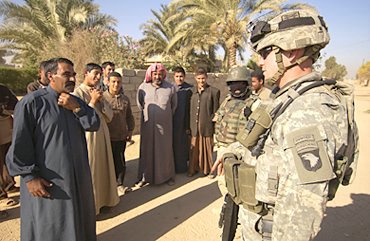
VISITING � U.S. Army 1st Lt. Jon Peifer talks with local people at a polling location in the village of Al-Mazra'a, Iraq, Dec. 9, 2005. Iraqi citizens will be voting on Dec. 15, 2005, to elect a parliamentary government that will lead this new democracy for the next four years. U.S. Air Force photo by Tech. Sgt. Andy Dunaway
Tuesday, December 13, 2005

Iraqi army 1st Lt. Merbad Abid Hassan, Charlie Company, 1st Battalion, inspects his platoon prior to heading out to the polling station to vote in Hayji, Iraq, Dec. 12, 2005. They will provide security on Dec. 15, 2005, when Iraqi citizens will elect their first permanent parliamentary government, which will lead the new democracy for the next four years. U.S. Air Force by Tech. Sgt. Andy Dunaway
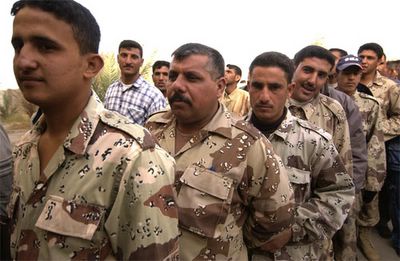
Iraqi army soldiers wait in line to vote along with other Iraqi security forces in Hayji, Iraq, Dec. 12, 2005. On Dec. 15, Iraqi citizens will elect their first permanent parliamentary government, which will lead the new democracy for the next four years. Iraqi security forces vote early so that they can provide security during the general election. U.S. Air Force by Tech. Sgt. Andy Dunaway
Three Soldiers Killed During Separate Incidents in Iraq
American Forces Press Service
WASHINGTON, Dec. 12, 2005 – One Task Force Baghdad soldier was killed south of Baghdad today. Another died in western Baghdad on Dec. 11. Both soldiers were killed when their patrols struck improvised explosive devices, military officials reported.
A third soldier, assigned to the 2nd Marine Division, 2nd Marine Expeditionary Force (Forward), was killed in a suicide car-bomb attack near Ramadi Dec. 11. Several U.S. Army units are attached to 2nd MEF (Forward) during Operation Iraqi Freedom.
The names of all three soldiers are being withheld pending notification the families.
In other news from Iraq, Iraqi soldiers captured an insurgent associated with a failed kidnapping of an Iraqi civilian and confiscated an 82 mm mortar system during a raid Dec. 11.
Troops from the 1st Brigade, 2nd Battalion, 5th Iraqi Army Division, handed the suspect and cache over to authorities pending further investigation. No injuries or damages were reported.
In the skies over Iraq, coalition aircraft flew 53 close-air-support missions Dec. 11 in support of Operation Iraqi Freedom. U.S. Air Force F-16s provided close-air support to coalition troops in contact with insurgent forces near Balad. Eleven U.S. Air Force and Navy intelligence, surveillance and reconnaissance aircraft also flew missions in support of operations in Iraq. British Royal Air Force fighter aircraft also performed in a nontraditional ISR role with their electro-optical and infrared sensors.
(Compiled from Multinational Force Iraq, Multinational Security Transition Command Iraq and U.S. Central Command Air Forces Forward news releases.)
WASHINGTON, Dec. 12, 2005 – One Task Force Baghdad soldier was killed south of Baghdad today. Another died in western Baghdad on Dec. 11. Both soldiers were killed when their patrols struck improvised explosive devices, military officials reported.
A third soldier, assigned to the 2nd Marine Division, 2nd Marine Expeditionary Force (Forward), was killed in a suicide car-bomb attack near Ramadi Dec. 11. Several U.S. Army units are attached to 2nd MEF (Forward) during Operation Iraqi Freedom.
The names of all three soldiers are being withheld pending notification the families.
In other news from Iraq, Iraqi soldiers captured an insurgent associated with a failed kidnapping of an Iraqi civilian and confiscated an 82 mm mortar system during a raid Dec. 11.
Troops from the 1st Brigade, 2nd Battalion, 5th Iraqi Army Division, handed the suspect and cache over to authorities pending further investigation. No injuries or damages were reported.
In the skies over Iraq, coalition aircraft flew 53 close-air-support missions Dec. 11 in support of Operation Iraqi Freedom. U.S. Air Force F-16s provided close-air support to coalition troops in contact with insurgent forces near Balad. Eleven U.S. Air Force and Navy intelligence, surveillance and reconnaissance aircraft also flew missions in support of operations in Iraq. British Royal Air Force fighter aircraft also performed in a nontraditional ISR role with their electro-optical and infrared sensors.
(Compiled from Multinational Force Iraq, Multinational Security Transition Command Iraq and U.S. Central Command Air Forces Forward news releases.)
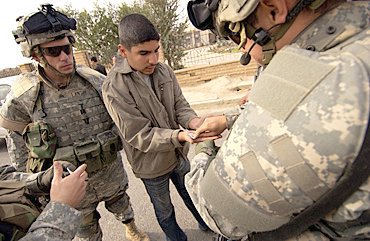
EXPLOSIVE TOUCH � U.S. Army soldiers use a swipe kit to determine if this local Iraqi has touched any type of explosive material to make improvised explosive devises in the city of Hayji, Iraq, Dec. 12, 2005. The soldiers are helping Iraqi security forces provide security for the upcoming Iraqi elections. U.S. Air Force photo by Tech. Sgt. Andy Dunaway
Monday, December 12, 2005

U.S. Marines from Golf Company, 2nd Battalion, 6th Marine Regiment, patrol through a field to search houses during an operation in Saqlawiyah, Iraq, Dec. 5, 2005. The 2nd Marine Division conducts counterinsurgency operations to facilitate the creation ofa secure environment that enables Iraqi self-reliance and self-governance. (U.S. Marine Corps photo by Lance Cpl. Mark E. Morrow)
IRAQ: OPERATION SKINNER CONCLUDES
December 11, 2005
Release Number: 05-12-30
FOR IMMEDIATE RELEASE
IRAQ: OPERATION SKINNER CONCLUDES
CAMP BLUE DIAMOND, Iraq — Iraqi Army Soldiers, U.S. Marines and Army Soldiers from 2nd Brigade Combat Team (28th Infantry Division) concluded Operation Gashshaar (Skinner) in central Ramadi Dec. 10.
The operation began on the evening of Dec. 7 and was the seventh disruption operation conducted in Ramadi since Nov. 16 to set conditions in the city for successful elections December 15.
The operation netted four weapons caches and several detainees and also two command-initiated rocket systems designed to ambush passing convoys in central Ramadi. The combined forces also discovered a roadside bomb that the terrorists planned to use in the rocket attack.
Iraqi and U.S. Forces also disrupted terrorist plans when they discovered a terrorist bomb-making factory in the center of the Ramadi shopping district. Artillery and mortar rounds, timers and remote detonators were found in the bomb making facility.
The previous operations conducted by the Iraqi Army and U.S. Forces in Ramadi recently were: Operation Panthers, Bruins, Lions, Tigers, Shank and Rams.
Details concerning Operation Skinner were not provided earlier due to operational security.
Release Number: 05-12-30
FOR IMMEDIATE RELEASE
IRAQ: OPERATION SKINNER CONCLUDES
CAMP BLUE DIAMOND, Iraq — Iraqi Army Soldiers, U.S. Marines and Army Soldiers from 2nd Brigade Combat Team (28th Infantry Division) concluded Operation Gashshaar (Skinner) in central Ramadi Dec. 10.
The operation began on the evening of Dec. 7 and was the seventh disruption operation conducted in Ramadi since Nov. 16 to set conditions in the city for successful elections December 15.
The operation netted four weapons caches and several detainees and also two command-initiated rocket systems designed to ambush passing convoys in central Ramadi. The combined forces also discovered a roadside bomb that the terrorists planned to use in the rocket attack.
Iraqi and U.S. Forces also disrupted terrorist plans when they discovered a terrorist bomb-making factory in the center of the Ramadi shopping district. Artillery and mortar rounds, timers and remote detonators were found in the bomb making facility.
The previous operations conducted by the Iraqi Army and U.S. Forces in Ramadi recently were: Operation Panthers, Bruins, Lions, Tigers, Shank and Rams.
Details concerning Operation Skinner were not provided earlier due to operational security.
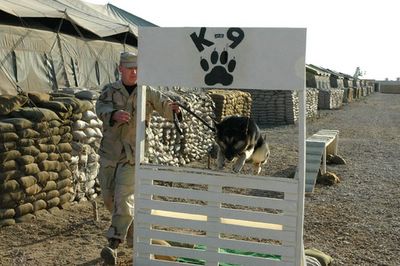
Hero of the week
Man�s best friend keeps Camp Victory safe
Story and photo by
Pfc. Joshua R. Ford
Multi-National Corps - Iraq
Public Affairs Office
CAMP VICTORY � Servicemembers from the Air Force, Army and Navy are protecting Camp Victory�s entry control points, not with weapons, but with their sense of smell.
Eighteen K-9s and their handlers attached to XVIII Airborne Corps, Headquarters and Headquarters Company, are on the job. The dogs sniff out explosives and identify car bombs, stopping terrorists before they can get onto Camp Victory.
�There are several types of explosive materials we are looking for out there,� said Army Sgt. William Brown, explosive dog handler, HHC, XVIII Abn. Corps. These explosive materials include C-4, dynamite and the not-so-common ingredients of other explosives.
The Soldiers, Sailors and Airmen train their dogs by conducting mock bomb sweeps with live explosives or taking them through a basic obedience course the handlers built.
�Our main reason for the basic obedience course is to challenge the dogs with unfamiliar surroundings, like having to jump through a window or run on narrow surfaces,� said Air Force Tech. Sgt. Leon Gray, explosive dog handler, HHC, XVIII Abn. Corps. �The course helps the dogs negotiate unusual surroundings.�
Since the handlers arrived in Iraq, they have learned a lot about each service�s method of training K-9s.
�Even though all the dogs have gone to the same school, each service has their own way of training the dogs and different ways of keeping records,� Gray said.
The dogs perform two main jobs.
�There are detection dogs and patrol dogs,� said Army Spc. Chris Tillman, explosive dog handler, HHC, XVIII Abn. Corps. Detection dogs are trained to sniff out illegal substances and explosive materials where patrol dogs are trained to track and attack the enemy.
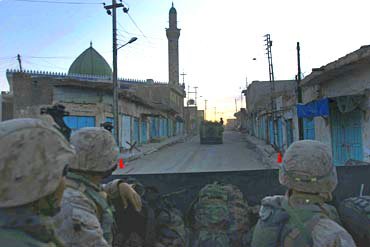
IRON HAMMER � U.S. Marines from Company G, Battalion Landing Team 2nd Battalion, 1st Marines, convoy through Hit, Iraq, at the conclusion of an offensive sweep through the area, Dec. 2, 2005. The ground combat element of the 13th Marine Expeditionary Unit (Special Operations Capable) patrolled a portion of the Euphrates River Valley during Operation Iron Hammer in search of insurgents. U.S. Marine Corps photo by Cpl. Andy Hurt Hi-Res Photo
Sunday, December 11, 2005
INTERESTING E-MAIL
ALLANON SAY" RECIEVED SOME INTERESTING E-MAIL OVER THE WEEKEND!", IF TRUE, THINGS WILL GET VERY INTERESTING IN IRAQ OVER THE NEXT 3 MONTHS! HANG ON TO YOUR HATS, THE SUNNI ENDGAME IS NEAR!

Five Soldiers Killed, One Dies of Heart Attack in Iraq
American Forces Press Service
WASHINGTON, Dec. 10, 2005 � Four Task Force Baghdad Soldiers were killed today and another Dec. 9. Elsewhere, a soldier died of a suspected heart attack in Kalsu, Iraq, Dec. 8, officials said.
Two Task Force Baghdad Soldiers were killed by small-arms fire in the Yusufiyah district, southwest of Baghdad today.
One Task Force Baghdad soldier was killed by small-arms fire while on patrol northwest of Baghdad today.
Another Task Force Baghdad soldier died when his patrol struck an improvised explosive device in the Adhamiyah district of northern Baghdad.
A Task Force Baghdad soldier died when a suicide car bomber attacked a unit operating in the Abu Ghraib district of western Baghdad Dec. 9. The terrorist attack also wounded 11 other soldiers and one Iraqi civilian.
The soldier who died of a heart attack Dec. 8 was assigned to the 155th Brigade Combat Team, 2nd Marine Expeditionary Force (Forward), and was on guard duty at a forward operating base.
The names of the deceased are being withheld pending notification of next of kin.
Elsewhere in Iraq, Task Force Baghdad soldiers from 2nd Battalion, 502nd Infantry Regiment, on patrol discovered a large cache of munitions in southwestern Baghdad Dec. 9. They found 180 40 mm rounds half-buried in the ground on the side of the road. The stockpile was near previous weapons cache sites discovered earlier by Task Force Baghdad soldiers. An explosive ordnance disposal team later destroyed the rounds, officials said.
(Compiled from Multinational Force Iraq news releases.)
U.S. Forces Dealing With Different Enemy in Anbar
By Jim Garamone
American Forces Press Service
CAMP FALLUJAH, Iraq, Dec. 10, 2005 – The enemy in Anbar province is different from that in other areas of Iraq, U.S. officials here said.
While terrorists and foreign fighters pose a continuing problem, most of those fighting coalition forces are Iraqi "rejectionists," Multinational Forces West officials said on background.
Officials characterize rejectionists as mostly Sunni Arabs who see the interim government in Baghdad as favoring Shiite and Kurdish interests. "There is a fear of Shiia dominance here," an official said. "There is also a fear of dominance by Iran." Roughly 60 percent of Iraq's population is Shiite. Twenty percent is Kurdish, and 20 percent Sunni Arab.
Sunnis boycotted January elections for a National Assembly to write the new national constitution. "While there were moves to increase Sunni representation in writing the constitution, most Sunnis believe their viewpoint was underrepresented," a U.S. embassy official said.
Yet, officials say, Sunnis recognized their mistake and will participate in Dec. 15 elections. Fallujah is a case in point. The city of more than 200,000 was a hotbed of insurgent activity in 2004. In December 2004, U.S. Marines and Army and Iraqi units went into the city and cleared terrorists out. In January 2005, only about 7,000 Fallujans voted in parliamentary elections. In the October 2005 constitutional referendum, more than 200,000 people in the greater Fallujah area voted, according to figures from the Independent Election Commission of Iraq. Officials expect that a greater number of Fallujans will vote Dec. 15.
In the provincial capital of Ramadi, the voting story is different, officials said. Before the October referendum, terrorists and Iraqi rejectionists intimidated the people of the city of about 500,000. Only about 4 percent of those eligible voted. Multinational Forces West officials believe they have improved the security situation in the city and that a far greater percentage of the population will vote Dec. 15.
Fear of domination by the Shiite majority has caused a two-track development in the province, officials said. Citizens are willing to participate in the election because they want their views heard and changes made. But they also still are willing to kill coalition troops, officials said.
One senior Multinational Force Iraq spokesman likened the situation to Sinn Fein in Northern Ireland: there are both militant and political wings of the Sunni camp.
Officials said it is important for any new government to produce results. Embassy officials said that most people in Iraq view the interim government as ineffective. Only the Iraqi security forces have a favorable rating and are respected, according to polls.
Traditional crime also complicates the security picture in Anbar. The border with Syria and Jordan was a construct after World War I. Family and tribal ties crisscross all borders in the region. Smuggling has been a way of life in the region for thousands of years, officials said.
Smugglers offer services to any who can pay. In addition to smuggling cigarettes, alcohol, electronics and porn, smugglers also bring in terrorists and the money suicide bombers need to carry out their missions.
Controlling the border with Syria has been tough. Officials said Syria has not done enough to stop the traffic across their border. Operations in the western Euphrates River Valley have disrupted smugglers' routes and stopped some of the flow of suicide bombers in to Iraq. But disrupting the smuggling routes means driving those involved more firmly into the ranks of Iraqi rejectionists.
"Nothing is easy or simple" in the region, a Multinational Forces West official said. Still, with all the challenges, it would be a mistake to "run out" on the Iraqis, the official said. "We need to hold our ground," he said. "It's worth doing."
American Forces Press Service
CAMP FALLUJAH, Iraq, Dec. 10, 2005 – The enemy in Anbar province is different from that in other areas of Iraq, U.S. officials here said.
While terrorists and foreign fighters pose a continuing problem, most of those fighting coalition forces are Iraqi "rejectionists," Multinational Forces West officials said on background.
Officials characterize rejectionists as mostly Sunni Arabs who see the interim government in Baghdad as favoring Shiite and Kurdish interests. "There is a fear of Shiia dominance here," an official said. "There is also a fear of dominance by Iran." Roughly 60 percent of Iraq's population is Shiite. Twenty percent is Kurdish, and 20 percent Sunni Arab.
Sunnis boycotted January elections for a National Assembly to write the new national constitution. "While there were moves to increase Sunni representation in writing the constitution, most Sunnis believe their viewpoint was underrepresented," a U.S. embassy official said.
Yet, officials say, Sunnis recognized their mistake and will participate in Dec. 15 elections. Fallujah is a case in point. The city of more than 200,000 was a hotbed of insurgent activity in 2004. In December 2004, U.S. Marines and Army and Iraqi units went into the city and cleared terrorists out. In January 2005, only about 7,000 Fallujans voted in parliamentary elections. In the October 2005 constitutional referendum, more than 200,000 people in the greater Fallujah area voted, according to figures from the Independent Election Commission of Iraq. Officials expect that a greater number of Fallujans will vote Dec. 15.
In the provincial capital of Ramadi, the voting story is different, officials said. Before the October referendum, terrorists and Iraqi rejectionists intimidated the people of the city of about 500,000. Only about 4 percent of those eligible voted. Multinational Forces West officials believe they have improved the security situation in the city and that a far greater percentage of the population will vote Dec. 15.
Fear of domination by the Shiite majority has caused a two-track development in the province, officials said. Citizens are willing to participate in the election because they want their views heard and changes made. But they also still are willing to kill coalition troops, officials said.
One senior Multinational Force Iraq spokesman likened the situation to Sinn Fein in Northern Ireland: there are both militant and political wings of the Sunni camp.
Officials said it is important for any new government to produce results. Embassy officials said that most people in Iraq view the interim government as ineffective. Only the Iraqi security forces have a favorable rating and are respected, according to polls.
Traditional crime also complicates the security picture in Anbar. The border with Syria and Jordan was a construct after World War I. Family and tribal ties crisscross all borders in the region. Smuggling has been a way of life in the region for thousands of years, officials said.
Smugglers offer services to any who can pay. In addition to smuggling cigarettes, alcohol, electronics and porn, smugglers also bring in terrorists and the money suicide bombers need to carry out their missions.
Controlling the border with Syria has been tough. Officials said Syria has not done enough to stop the traffic across their border. Operations in the western Euphrates River Valley have disrupted smugglers' routes and stopped some of the flow of suicide bombers in to Iraq. But disrupting the smuggling routes means driving those involved more firmly into the ranks of Iraqi rejectionists.
"Nothing is easy or simple" in the region, a Multinational Forces West official said. Still, with all the challenges, it would be a mistake to "run out" on the Iraqis, the official said. "We need to hold our ground," he said. "It's worth doing."
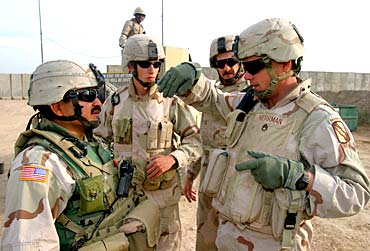
SECURITY PROCEDURES � U.S. Army Staff Sgt. Dale Herrman, right, assigned to Bravo Company, 490th Civil Affairs Battalion, 155th Brigade Combat Team, describes to Sgt. 1st Class Anthony Abeyta the procedures to escort a group of Iraqis, who operate the dump trucks at the north gate of Forward Operating Base Kalsu, Iraq, Dec. 6, 2005. U.S. Marine Corps photo by Lance Cpl. Michael J. O'Brien
Photo's Wanted!
IRAQ PHOTO'S WANTED! WE NEED FRESH PHOTO'S DAILY!, E-MAIL US- iraqibountyhunter@yahoo.com OR VISIT OUR SISTER SITE @ http://www.royaltyfreestockphotogallery.com/index.php
IF YA GOTTA GO, MAKE MONEY!
IF YA GOTTA GO, MAKE MONEY!
Saturday, December 10, 2005
Citizens Turn Over 'Butcher of Ramadi' to Iraqi, U.S. Troops
American Forces Press Service
WASHINGTON, Dec. 9, 2005 – The terrorist known as "the Butcher of Ramadi" was detained today, turned in by local citizens in the provincial capital of Iraq's Anbar province, U.S. military officials in Iraq reported.
Amir Khalaf Fanus -- listed third on a "high-value individuals" list of terrorists wanted by the 28th Infantry Division's 2nd Brigade Combat Team -- was wanted for criminal activities including murder and kidnapping. Ramadi citizens brought him to an Iraqi and U.S. forces military base in Ramadi, where he was taken into custody.
Fanus was well known for his crimes against the local populace. He is the highest-ranking al Qaeda in Iraq member to be turned in to Iraqi and U.S. officials by local citizens.
His capture is another indication that the local citizens tire of the terrorists' presence within their community, Multinational Force Iraq officials said, adding that Iraqi and U.S. forces have witnessed increasing signs of citizens fighting the terrorists in Ramadi as the Dec. 15 national elections draw near.
Officials said 1,200 more Iraqi soldiers recently have been posted in Ramadi. About 1,100 Iraqi special police commandos and a mechanized Iraqi army company completed their planned movement into the city. This plan has Iraqi security forces assuming more of the security responsibilities from the U.S. forces, officials said. As in other locations, as security improves, Iraqi police also will be introduced gradually.
(From a Multinational Force Iraq news release.)
WASHINGTON, Dec. 9, 2005 – The terrorist known as "the Butcher of Ramadi" was detained today, turned in by local citizens in the provincial capital of Iraq's Anbar province, U.S. military officials in Iraq reported.
Amir Khalaf Fanus -- listed third on a "high-value individuals" list of terrorists wanted by the 28th Infantry Division's 2nd Brigade Combat Team -- was wanted for criminal activities including murder and kidnapping. Ramadi citizens brought him to an Iraqi and U.S. forces military base in Ramadi, where he was taken into custody.
Fanus was well known for his crimes against the local populace. He is the highest-ranking al Qaeda in Iraq member to be turned in to Iraqi and U.S. officials by local citizens.
His capture is another indication that the local citizens tire of the terrorists' presence within their community, Multinational Force Iraq officials said, adding that Iraqi and U.S. forces have witnessed increasing signs of citizens fighting the terrorists in Ramadi as the Dec. 15 national elections draw near.
Officials said 1,200 more Iraqi soldiers recently have been posted in Ramadi. About 1,100 Iraqi special police commandos and a mechanized Iraqi army company completed their planned movement into the city. This plan has Iraqi security forces assuming more of the security responsibilities from the U.S. forces, officials said. As in other locations, as security improves, Iraqi police also will be introduced gradually.
(From a Multinational Force Iraq news release.)
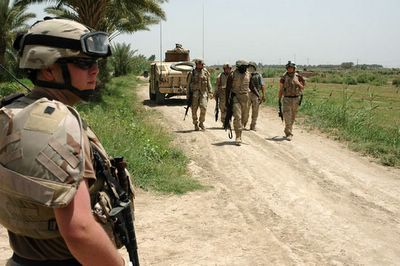
Army Unit Sees Less Terror Activity in Southwestern Iraq
By Gerry J. Gilmore
American Forces Press Service
WASHINGTON, Dec. 9, 2005 � After nearly a year since their posting in southwestern Iraq, a U.S. Army commander today said he and his 4,200 soldiers have witnessed decreased terrorist activity in their area of operations.
Brig. Gen. Augustus L. Collins commands the 155th Brigade Combat Team. Since February, his unit has been responsible for security and stability operations in Babil, Karbala and Najaf provinces, with a detachment in eastern Anbar province.
"Actually, the attacks that we have now compared to attacks we had when we first got here and took over our battlespace in February are at least down by 50 percent," Collins told Pentagon reporters during a satellite teleconference.
The 155th is a mix of National Guard soldiers from Mississippi, Iowa, Vermont, Utah, Arkansas and Puerto Rico, as well as a squadron of active troops from the 11th Armored Cavalry Regiment from Fort Irwin, Calif. The unit falls under the 2nd Marine Expeditionary Force during its Operation Iraqi Freedom deployment.
The 155th's soldiers have conducted more than 500 operations so far during their tour in Iraq, Collins said, ranging from the brigade level down to company- and platoon-level participation.
Those operations are partly responsible for the decreased enemy activity in his sector, Collins said, noting his soldiers have netted nearly 1,500 enemy captives and seized 2,800 weapons. Almost 200 attacks occurred monthly in his area almost a year ago, Collins said, compared to about 100 per month now.
Collins said Iraqi citizens and local government efforts also deserve much credit for the reduced terrorist activity.
"When we first got here, the people didn't really talk to us that much," Collins said, "but now they've opened up to us. And they see that the way to peace is through this democratic idea that we're trying to share with them."
Collins said his staff works closely with Iraqi provincial officials to identify their humanitarian and rebuilding needs. And local Iraqi citizens are now working with U.S. and Iraqi security forces to root out terrorists, he said.
"They're helping us find the insurgents and then turn them over to us, to where we can arrest them and get them off the street," the general said.
Collins' soldiers have confiscated enemy weapons caches containing 18,000 munitions, which, he said, has helped to reduce the effectiveness of terrorist attacks in the area.
"We've taken a lot of the things that the enemy was using against us to try to kill or hurt our soldiers," Collins explained, "so now they don't have as robust an inventory of things to use as they once did."
Collins said Iraqi soldiers and police are taking a larger role in security operations in his area of operations. In fact, the Iraq police and army now have responsibility for security in the city of Najaf, he said.
"Tbey have done a great job," Collins said, "as far as being able to provide a safe and secure environment for the people of Najaf." Many buildings have been renovated in Najaf, and the markets are open, he said.
"Everything is going in the right direction as far as Najaf is concerned," the general said, noting that religious pilgrims have begun returning to Najaf to visit its famous shrine.
Collins said his troops helped to renovate part of the Najaf Teaching Hospital that now treats 400 patients daily. And after renovations, the city's soccer stadium reopened in October for a game between the Baghdad and Najaf clubs, he said, that attracted 20,000 spectators.
Iraqi army soldiers and police have received weapons, uniforms, vehicles and increased training during the past year, Collins said. Thanks to better equipment and training, he noted, the police have become a much more professional force.
Collins said he is very impressed with the two Iraqi army brigades and the three battalions that operate across the three provinces. "They have really increased in their ability since we first got here," Collins said, noting his soldiers routinely conduct operations and training with Iraqi troops.
Iraqi soldiers and police will take the lead security role for the Dec. 15 Iraq election voting in his sector, Collins said. His troops will be positioned to provide security assistance if required, he said.
"Right now, based on the last two elections and, I think, the progress that the Iraqi security forces have made, we really don't anticipate having to do anything on election day," Collins said.
Collins saluted his soldiers and offered his condolences to the families of those who have been killed or wounded.
"For the last 11 months, I've had the opportunity to serve with the absolute best soldiers that the United States has to offer," Collins said. "Every day they surprise me with their level of commitment."
Collins expressed his sentiments toward the soldiers who have given their lives. "Words can't express the grief that we have," he said. "Those soldiers were our friends. We fought alongside of them. We miss them, and they will always be heroes in our eyes."
Iraq Update
Operations Net Suspects and Terror Tools in Iraq
American Forces Press Service
WASHINGTON, Dec. 9, 2005 – Iraqi and U.S. forces continued to make progress in the fight against terrorism in the north-central region of Iraq, detaining suspects and netting weapons and ammunition, officials in Iraq reported today.
Raids and patrols throughout the area Dec. 8 resulted in the detention of 22 suspected terrorists and the discovery of four weapons caches, officials said.
In an early morning raid near Duluiyah, soldiers from the 3rd Battalion, 1st Brigade, 4th Iraqi Army Division, captured seven suspected terrorists. The men were wanted for staging roadside bomb and mortar attacks against coalition forces in the area.
Iraqi troops from 2nd Battalion, 2nd Brigade, 5th Division, working with U.S. soldiers from the 3rd Infantry Division's 3rd Brigade Combat Team, detained five suspects in Mansuriyah al Jabal, a village near the city of Muqdadiyah.
In addition, Iraqi Ministry of the Interior troops and U.S. soldiers from the 3rd Infantry Division's 1st BCT detained five other suspects following a combined raid near Samarra, officials reported.
A 1st BCT patrol discovered the biggest cache of the day, west of Balad. An explosives ordnance disposal team destroyed more than 100 hand grenades, 45 pounds of gunpowder, 2 pounds of plastic explosives, a preassembled roadside bomb and various other items, officials said. Three suspected terrorists were detained at the site.
Two other caches found in the same area yielded 23 mortar rounds, 300 artillery fuses, four blocks of plastic explosives, a mortar tube and a rocket-propelled grenade launcher. Explosive ordnance disposal teams destroyed both caches.
Iraqi soldiers from 2nd Battalion, 2nd Brigade, 5th Iraqi Army Division, discovered another cache in the village of Haroniyah near Muqdadiyah. The cache contained nine mortar rounds that had been converted into improvised explosive devices and four RPG launchers. Two men were detained in connection with the weapons, officials said.
In other developments, officials announced Dec. 8 that a Marine assigned to the 2nd Marine Division, 2nd Marine Expeditionary Force (Forward), was killed in action Dec. 7. The Marine's vehicle was attacked with an IED during combat operations against the enemy in Ramadi. Officials are withholding the Marine's name until the family is notified.
Also on Dec. 8, Iraqi soldiers and police, along with U.S. troops, successfully conducted two separate operations near Baqubah that resulted in the capture of 14 suspected terrorists, officials said.
Operation Bulldawg Chariot, a joint mission with soldiers from Iraq's 3rd Battalion, 2nd Brigade, 5th Army Division, and U.S. soldiers from the 3rd Infantry Division's 3rd BCT netted four suspected terrorists.
A tip from an Iraqi civilian led to the operation to nab suspected terrorists who were harassing, threatening and intimidating local Iraqi civilian construction workers who are building a new prison facility, officials said.
In Khadasia, northwest of Tikrit, Operation Able Rising Force unfolded with 10 suspected terrorists captured, including three who are wanted for IED attacks against local civilians and military. Iraqi soldiers from 1st Battalion, 1st Brigade, 4th Iraqi Army Division, Iraqi police from the area and soldiers from the 3rd Infantry Division's 1st BCT, participated.
Soldiers with the 2nd Battalion, 2nd Brigade, 5th Iraqi Army Division, detained two men after discovering a large cache of weapons and munitions Dec. 8 in the village of Haroniyah, northeast of Muqdadiyah.
The cache consisted of nine 60 mm mortars configured to be used as roadside bombs, four rocket-propelled grenade launchers, an antitank weapon known as a SPG-9 with one round and a television remote control. The suspects were held for further investigation.
Elsewhere the same day, soldiers with the 4th Battalion, 1st Brigade, 4th Iraqi Army Division, unearthed two caches buried near Balad in Salah Ad Din province. The find included 16 60 mm rounds, 16 artillery fuses and a technical manual for computers. Explosive ordnance disposal experts handled the scene.
And a car bomb exploded in Tikrit shortly after Iraqi police discovered it Dec. 8. Coalition forces, ambulances and fire trucks were called in to assist the police in establishing an initial cordon when the bomb, contained in a green minivan, exploded. No injuries or damages were reported.
Earlier this week, two insurgents attacked a patrol from the 10th Mountain Division's 1st Battalion, 87th Infantry, 1st Brigade Combat Team.
The terrorists engaged the U.S. patrol with small-arms fire in the Dec. 6 incident before driving away in their white sedan, officials said.
The patrol pursued the vehicle and detained both suspects, officials said. While searching the vehicle, the soldiers found $5,000 in U.S. cash, two pistols, cell phones and ammunition.
Coalition aircraft flew 34 close-air-support missions Dec. 8 for Operation Iraqi Freedom, and a U.S. Air Force Predator struck an enemy improvised explosive device location near Rawah.
Ten U.S. Air Force and U.S. Navy intelligence, surveillance and reconnaissance aircraft flew missions in support of operations in Iraq. Royal Air Force fighter aircraft performed in a nontraditional ISR role with their electro-optical and infrared sensors.
(Compiled from Multinational Force Iraq , Multinational Security Transition Command Iraq, Task Force Baghdad and U.S. Central Command Air Forces Forward news releases.)
American Forces Press Service
WASHINGTON, Dec. 9, 2005 – Iraqi and U.S. forces continued to make progress in the fight against terrorism in the north-central region of Iraq, detaining suspects and netting weapons and ammunition, officials in Iraq reported today.
Raids and patrols throughout the area Dec. 8 resulted in the detention of 22 suspected terrorists and the discovery of four weapons caches, officials said.
In an early morning raid near Duluiyah, soldiers from the 3rd Battalion, 1st Brigade, 4th Iraqi Army Division, captured seven suspected terrorists. The men were wanted for staging roadside bomb and mortar attacks against coalition forces in the area.
Iraqi troops from 2nd Battalion, 2nd Brigade, 5th Division, working with U.S. soldiers from the 3rd Infantry Division's 3rd Brigade Combat Team, detained five suspects in Mansuriyah al Jabal, a village near the city of Muqdadiyah.
In addition, Iraqi Ministry of the Interior troops and U.S. soldiers from the 3rd Infantry Division's 1st BCT detained five other suspects following a combined raid near Samarra, officials reported.
A 1st BCT patrol discovered the biggest cache of the day, west of Balad. An explosives ordnance disposal team destroyed more than 100 hand grenades, 45 pounds of gunpowder, 2 pounds of plastic explosives, a preassembled roadside bomb and various other items, officials said. Three suspected terrorists were detained at the site.
Two other caches found in the same area yielded 23 mortar rounds, 300 artillery fuses, four blocks of plastic explosives, a mortar tube and a rocket-propelled grenade launcher. Explosive ordnance disposal teams destroyed both caches.
Iraqi soldiers from 2nd Battalion, 2nd Brigade, 5th Iraqi Army Division, discovered another cache in the village of Haroniyah near Muqdadiyah. The cache contained nine mortar rounds that had been converted into improvised explosive devices and four RPG launchers. Two men were detained in connection with the weapons, officials said.
In other developments, officials announced Dec. 8 that a Marine assigned to the 2nd Marine Division, 2nd Marine Expeditionary Force (Forward), was killed in action Dec. 7. The Marine's vehicle was attacked with an IED during combat operations against the enemy in Ramadi. Officials are withholding the Marine's name until the family is notified.
Also on Dec. 8, Iraqi soldiers and police, along with U.S. troops, successfully conducted two separate operations near Baqubah that resulted in the capture of 14 suspected terrorists, officials said.
Operation Bulldawg Chariot, a joint mission with soldiers from Iraq's 3rd Battalion, 2nd Brigade, 5th Army Division, and U.S. soldiers from the 3rd Infantry Division's 3rd BCT netted four suspected terrorists.
A tip from an Iraqi civilian led to the operation to nab suspected terrorists who were harassing, threatening and intimidating local Iraqi civilian construction workers who are building a new prison facility, officials said.
In Khadasia, northwest of Tikrit, Operation Able Rising Force unfolded with 10 suspected terrorists captured, including three who are wanted for IED attacks against local civilians and military. Iraqi soldiers from 1st Battalion, 1st Brigade, 4th Iraqi Army Division, Iraqi police from the area and soldiers from the 3rd Infantry Division's 1st BCT, participated.
Soldiers with the 2nd Battalion, 2nd Brigade, 5th Iraqi Army Division, detained two men after discovering a large cache of weapons and munitions Dec. 8 in the village of Haroniyah, northeast of Muqdadiyah.
The cache consisted of nine 60 mm mortars configured to be used as roadside bombs, four rocket-propelled grenade launchers, an antitank weapon known as a SPG-9 with one round and a television remote control. The suspects were held for further investigation.
Elsewhere the same day, soldiers with the 4th Battalion, 1st Brigade, 4th Iraqi Army Division, unearthed two caches buried near Balad in Salah Ad Din province. The find included 16 60 mm rounds, 16 artillery fuses and a technical manual for computers. Explosive ordnance disposal experts handled the scene.
And a car bomb exploded in Tikrit shortly after Iraqi police discovered it Dec. 8. Coalition forces, ambulances and fire trucks were called in to assist the police in establishing an initial cordon when the bomb, contained in a green minivan, exploded. No injuries or damages were reported.
Earlier this week, two insurgents attacked a patrol from the 10th Mountain Division's 1st Battalion, 87th Infantry, 1st Brigade Combat Team.
The terrorists engaged the U.S. patrol with small-arms fire in the Dec. 6 incident before driving away in their white sedan, officials said.
The patrol pursued the vehicle and detained both suspects, officials said. While searching the vehicle, the soldiers found $5,000 in U.S. cash, two pistols, cell phones and ammunition.
Coalition aircraft flew 34 close-air-support missions Dec. 8 for Operation Iraqi Freedom, and a U.S. Air Force Predator struck an enemy improvised explosive device location near Rawah.
Ten U.S. Air Force and U.S. Navy intelligence, surveillance and reconnaissance aircraft flew missions in support of operations in Iraq. Royal Air Force fighter aircraft performed in a nontraditional ISR role with their electro-optical and infrared sensors.
(Compiled from Multinational Force Iraq , Multinational Security Transition Command Iraq, Task Force Baghdad and U.S. Central Command Air Forces Forward news releases.)
Friday, December 09, 2005

on the signal bridge of the aircraft carrier USS Kitty Hawk (CV 63) during a general quarters drill on Dec. 6, 2005. The Kitty Hawk Carrier Strike Group is operating in the South China Sea from its homeport of Yokosuka, Japan. Phommalinh is a Navy quartermaster. DoD photo by Airman Kyle D. Gahlau, U.S. Navy. (Released)

U.S. Marines emerge from a cloud of dust kicked up by the rotor wash of a CH-46 Sea Knight helicopter in Iraq on Dec. 4, 2005. The Marines and Navy Criminal Investigation Service agents are investigating the site as an alleged insurgent sniper range. DoD photo by Lance Cpl. Sheila M. Brooks, U.S. Marine Corps. (Released)
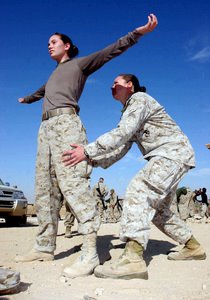
News Photo Home
U.S. Marines practice personnel search procedures on other Marines during a training in Al Asad, Iraq, on Dec. 6, 2005. Marines of the 2nd Marine Aircraft Wing are training to provide security for the December elections in Iraq. DoD photo by Lance Cpl. Sheila M. Brooks, U.S. Marine Corps. (Released)

Navy Petty Officer 1st Class Eric Sutton jumps into the Pacific Ocean from a hovering MH-60S Seahawk helicopter during a search and rescue training exercise off the coast of Guam on Dec. 8, 2005. Sutton, a Navy aviation machinist's mate, is a search and rescue swimmer attached to Helicopter Sea Combat Squadron 25 deployed to Anderson Air Force Base, Guam. DoD photo by Airman Edwin Alcaraz, U.S. Navy. (Released)
Top of Form 1 Search Bottom of Form 1
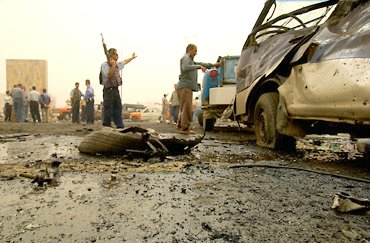
Roadside Bomb Claims Soldier; Suicide Bomber Kills 19 Civilians American Forces Press Service
WASHINGTON, Dec. 8, 2005 � A Task Force Baghdad soldier was killed today when a convoy he was riding in struck an improvised explosive device in eastern Baghdad, military officials said. The soldier's name is being withheld pending notification of next of kin. Also in eastern Baghdad today, at least 19 civilians were killed and 13 others were injured when a suicide bomber detonated a vest packed with explosives on a bus loaded with about 40 passengers, officials said. Soldiers from 2nd Brigade, 6th Iraqi Army Division, secured the site and immediately began evacuating the wounded to local hospitals, officials said. Elsewhere, Iraqi soldiers detained two military-aged men Dec. 7 after local citizens pointed them out as being responsible for placing two hand grenades on the ground. Soldiers with the 3rd Battalion, 4th Brigade, 1st Iraqi Intervention Force, had surrounded a munitions site in central Fallujah when several citizens approached them about the men. The suspects are being detained pending further investigation by authorities. Based on intelligence reports, a man suspected of conducting attacks on coalition forces was detained Dec. 7 by soldiers with the 1st Battalion, 2nd Brigade, 7th Iraqi Army Division, near Hit, officials said. Air Force officials reported today that coalition aircraft flew 62 close-air-support missions Dec. 7 for Operation Iraqi Freedom. Also, Air Force Predator -- an advanced concept technology demonstration aircraft -- fired a Hellfire missile, destroying an enemy improvised explosive device location near Rawah, officials said. Air Force F-16 Fighting Falcons, Navy F/A-18 Hornets and an EA-6B Prowler provided close-air support to coalition troops near Ramadi. In other aerial action, 15 Air Force, Navy, and Royal Australian Air Force intelligence, surveillance and reconnaissance aircraft flew missions in support of operations in Iraq. Also, Royal Air Force fighter aircraft performed in a nontraditional ISR role with their electro-optical and infrared sensors. (Compiled from Multinational Force Iraq, Multinational Security Transition Command Iraq and U.S. Central Command Air Forces Forward news releases.)
